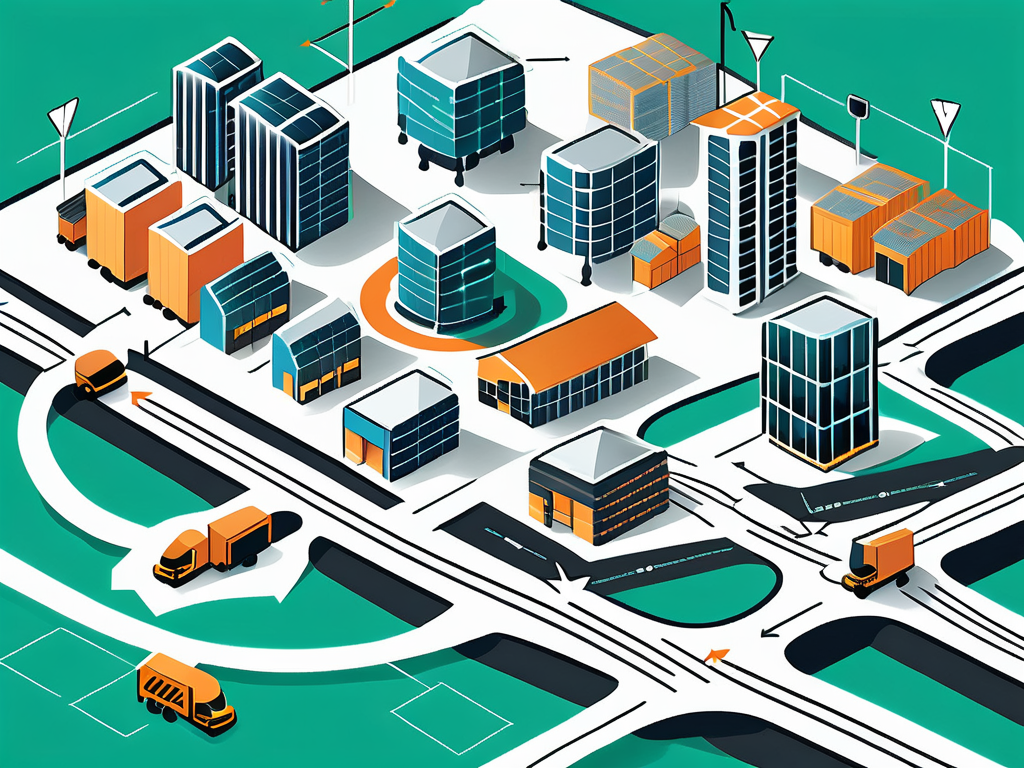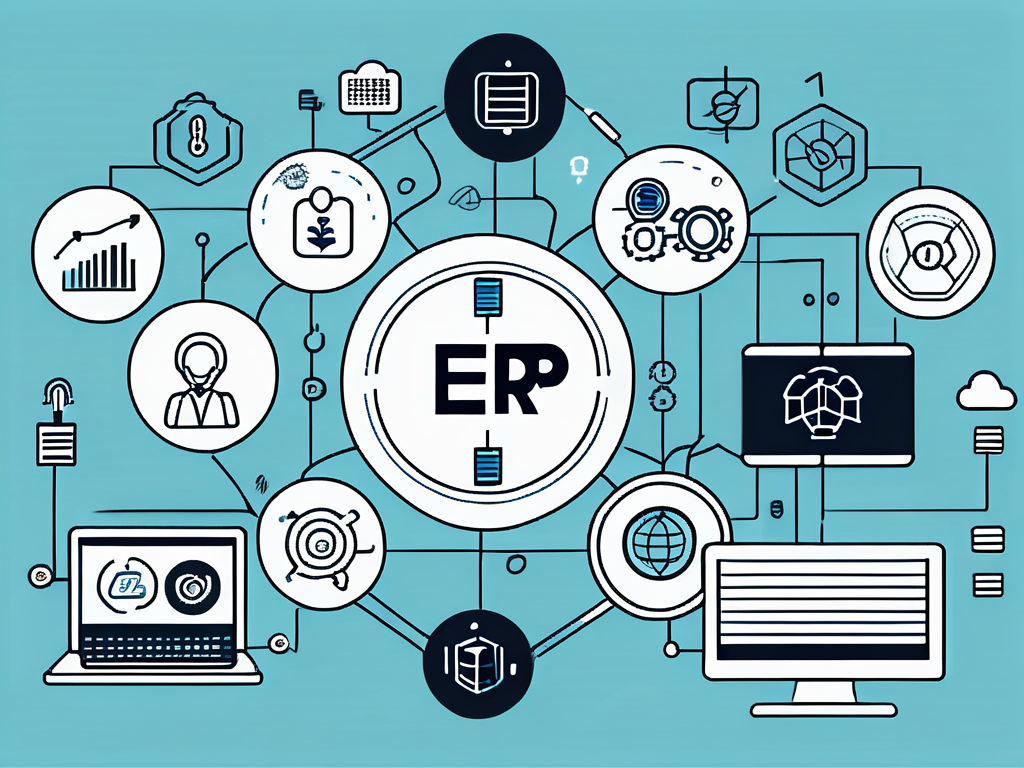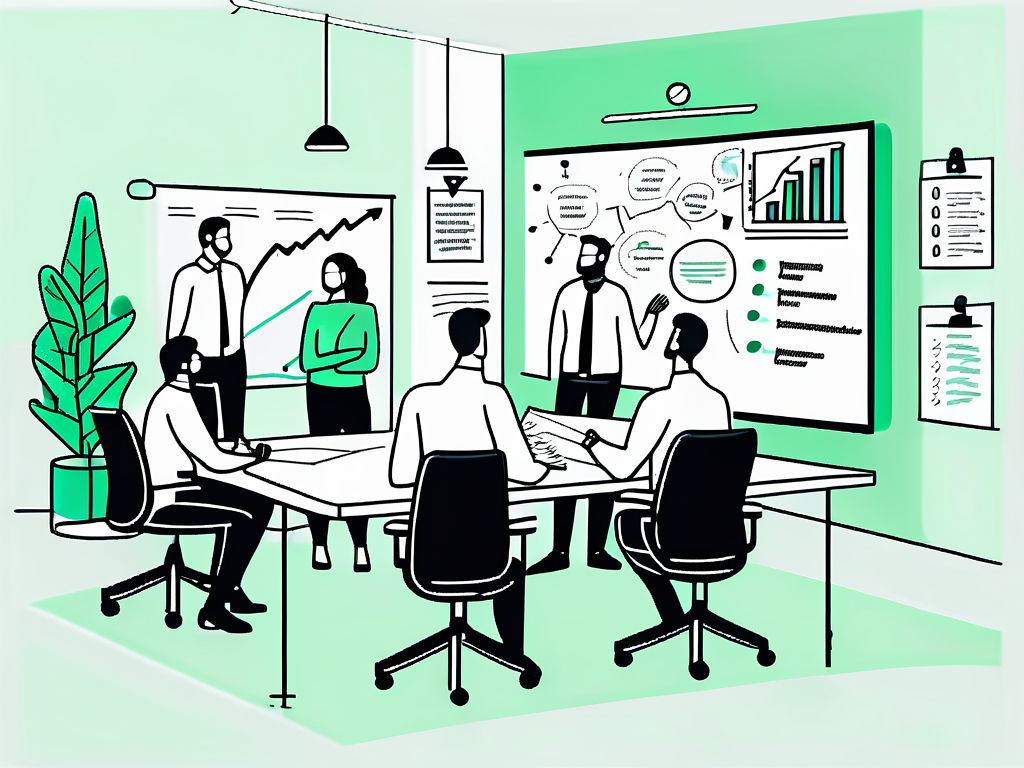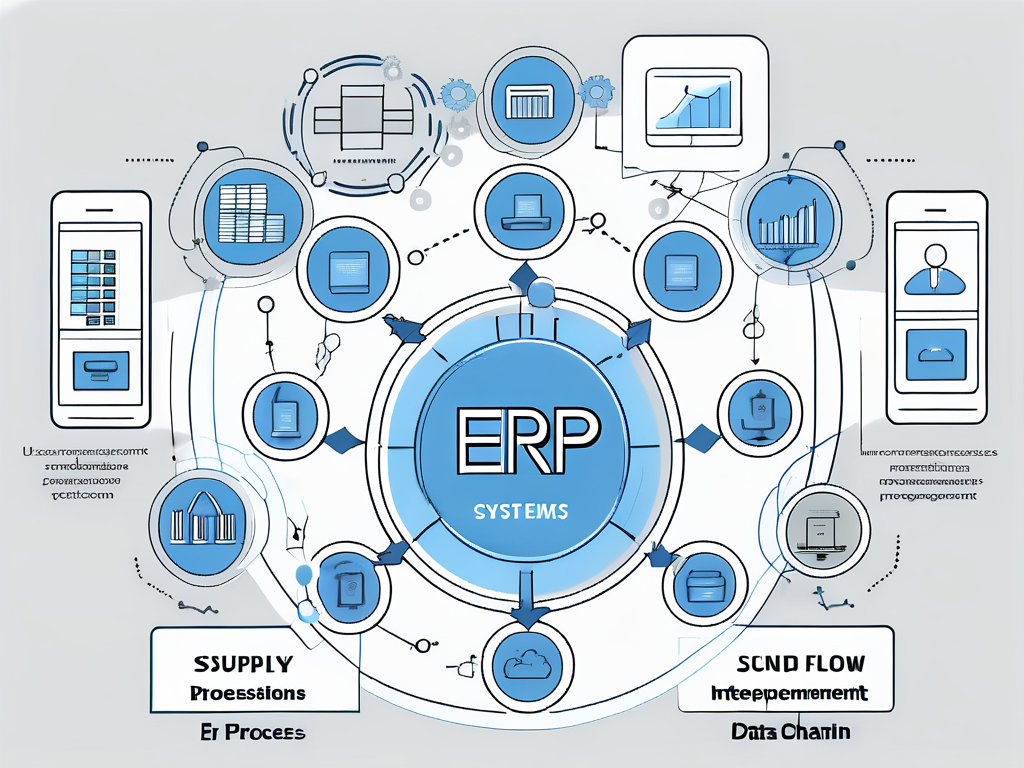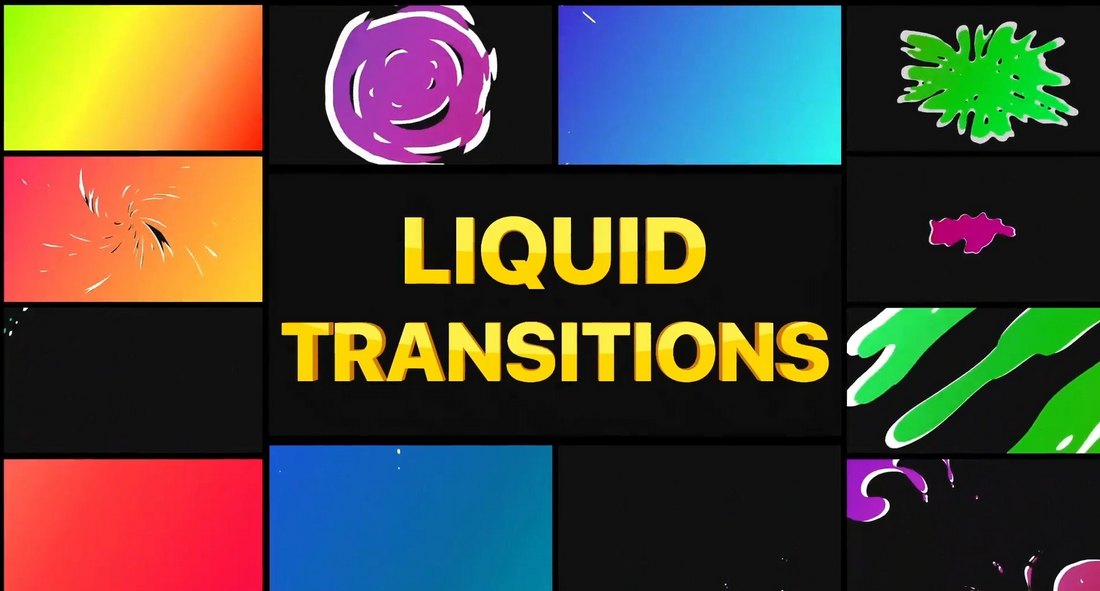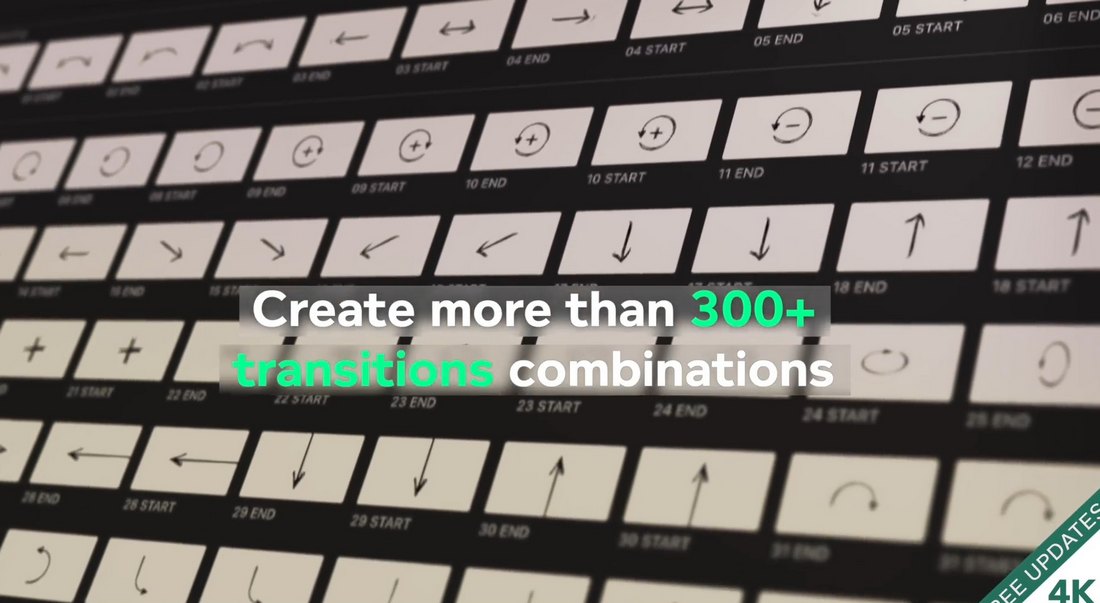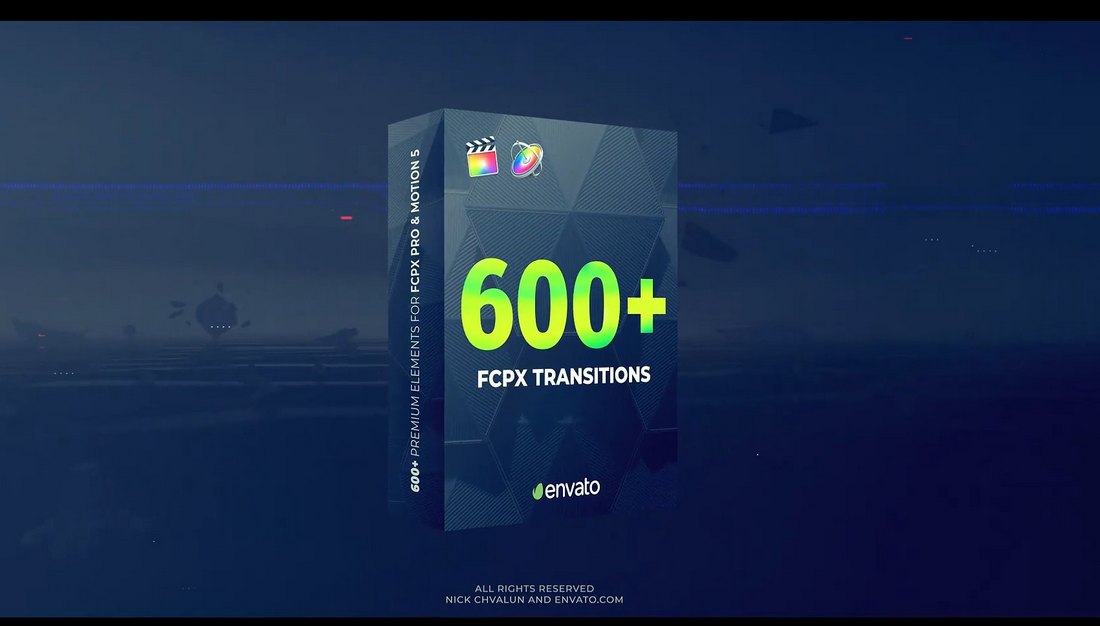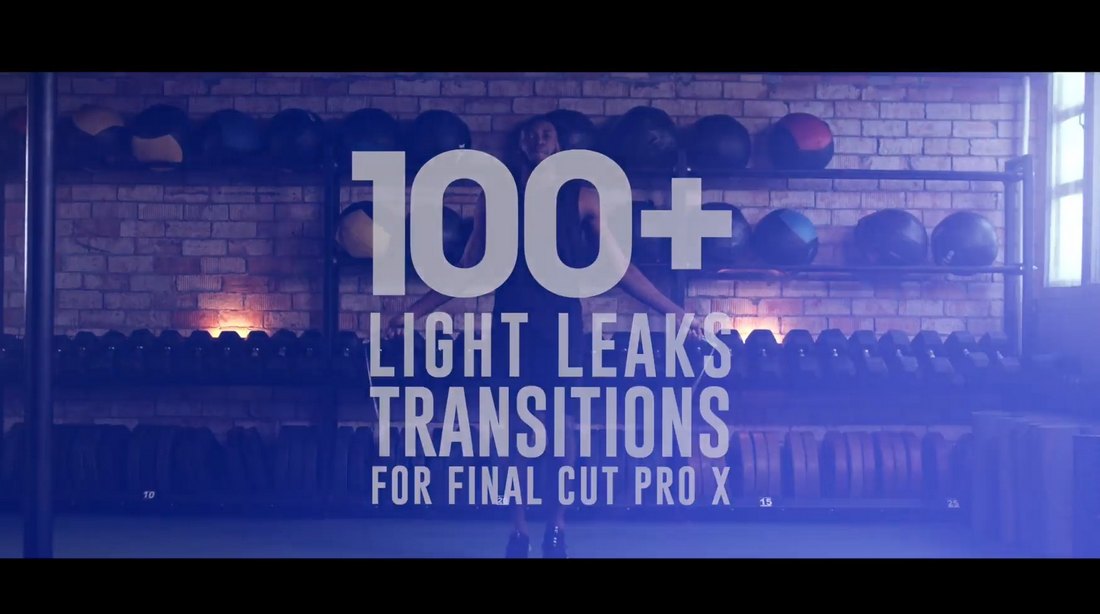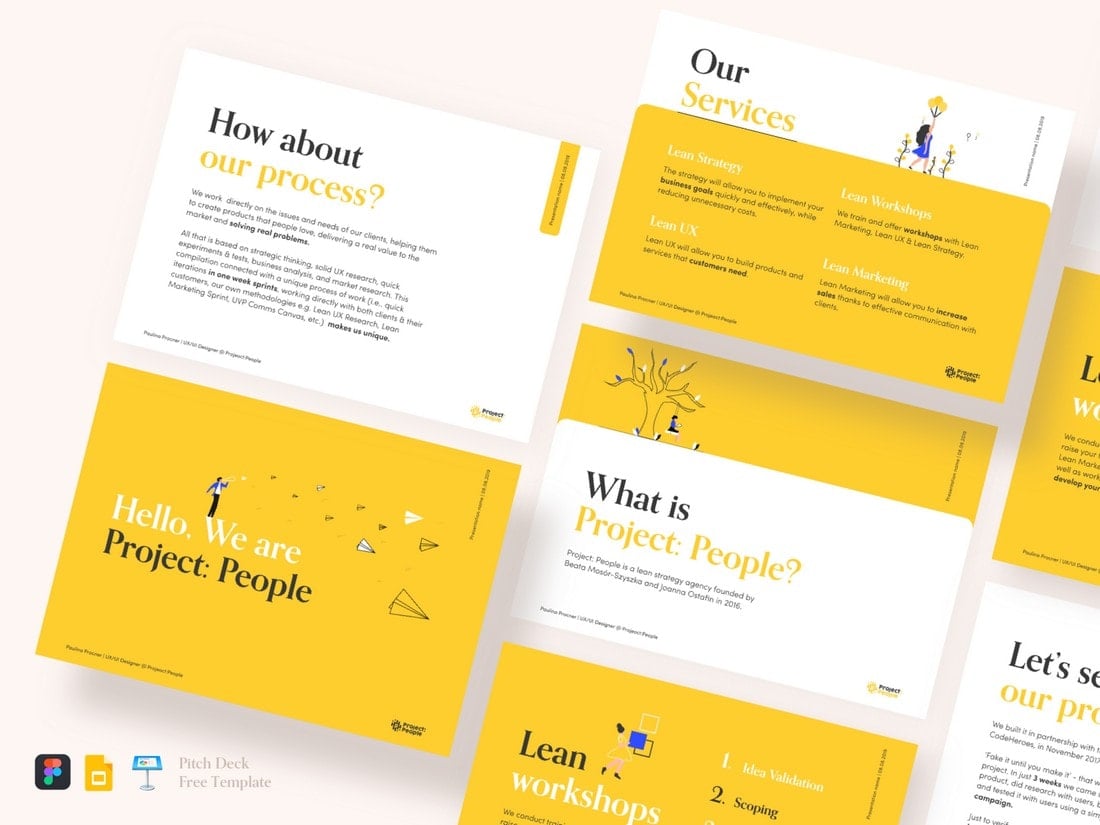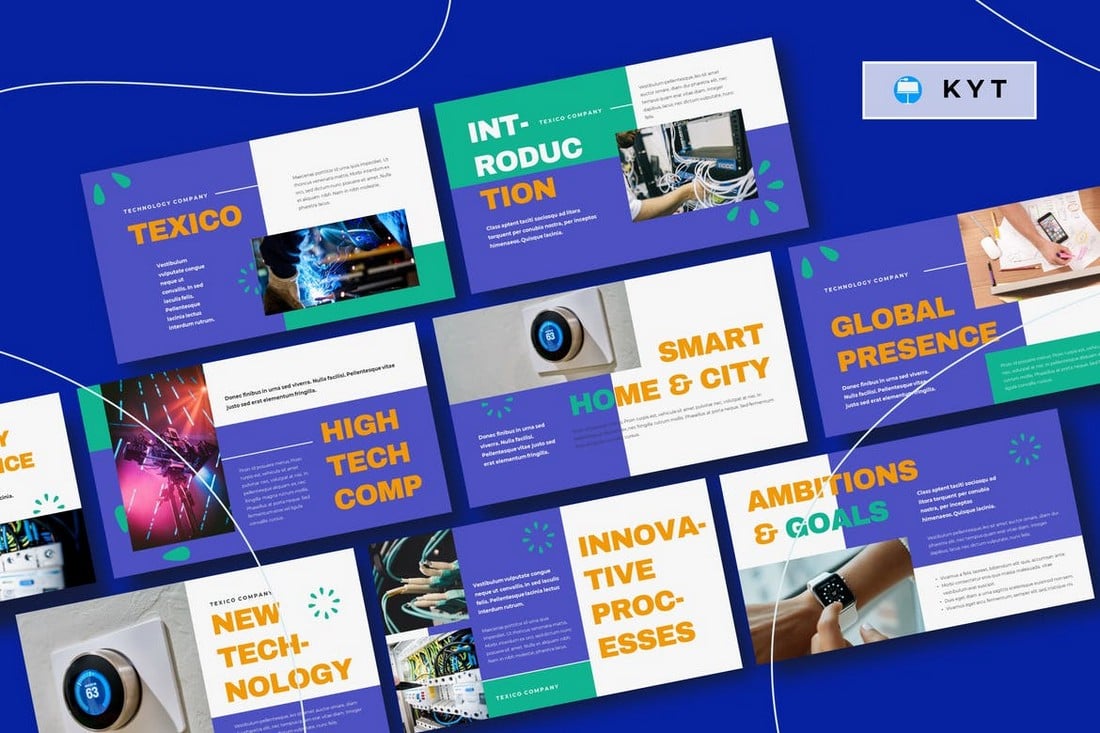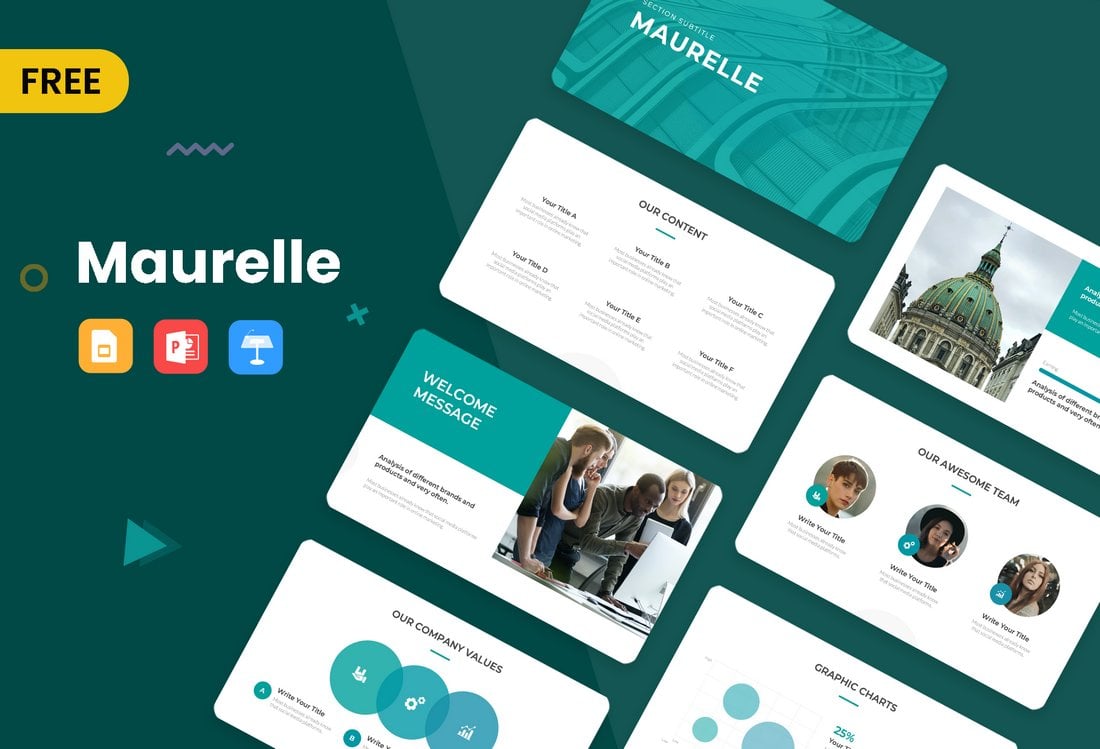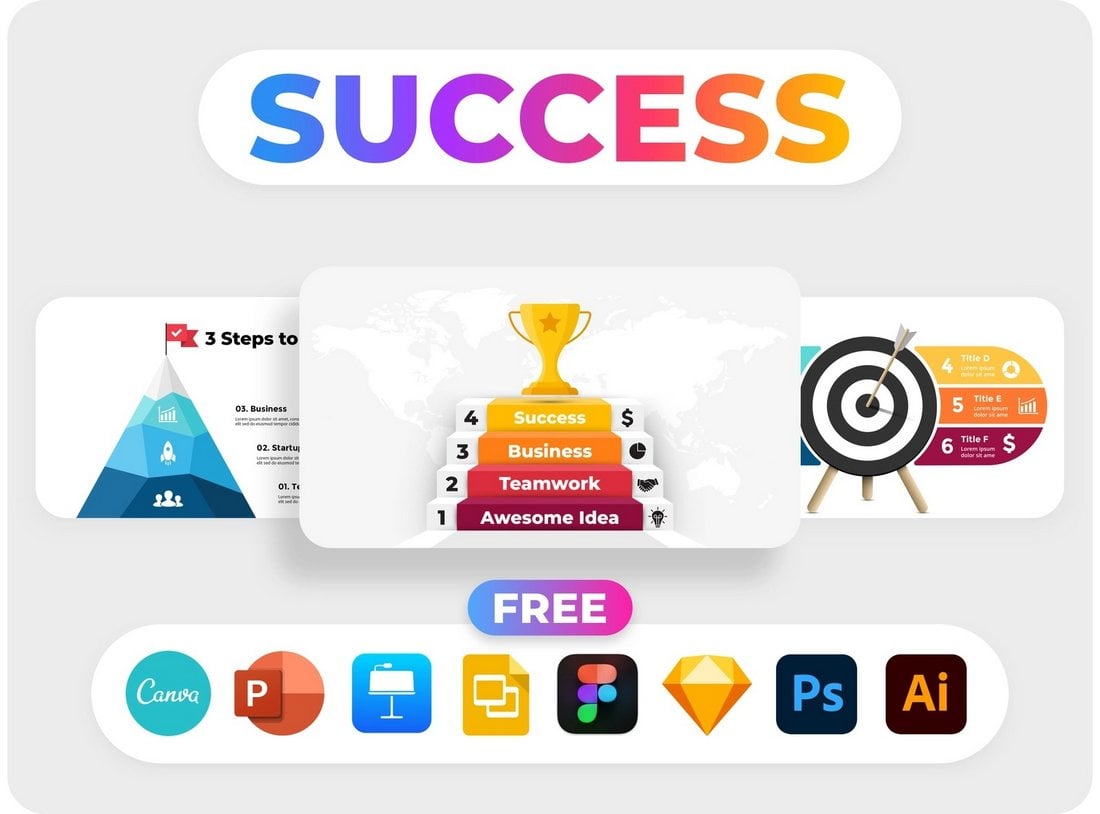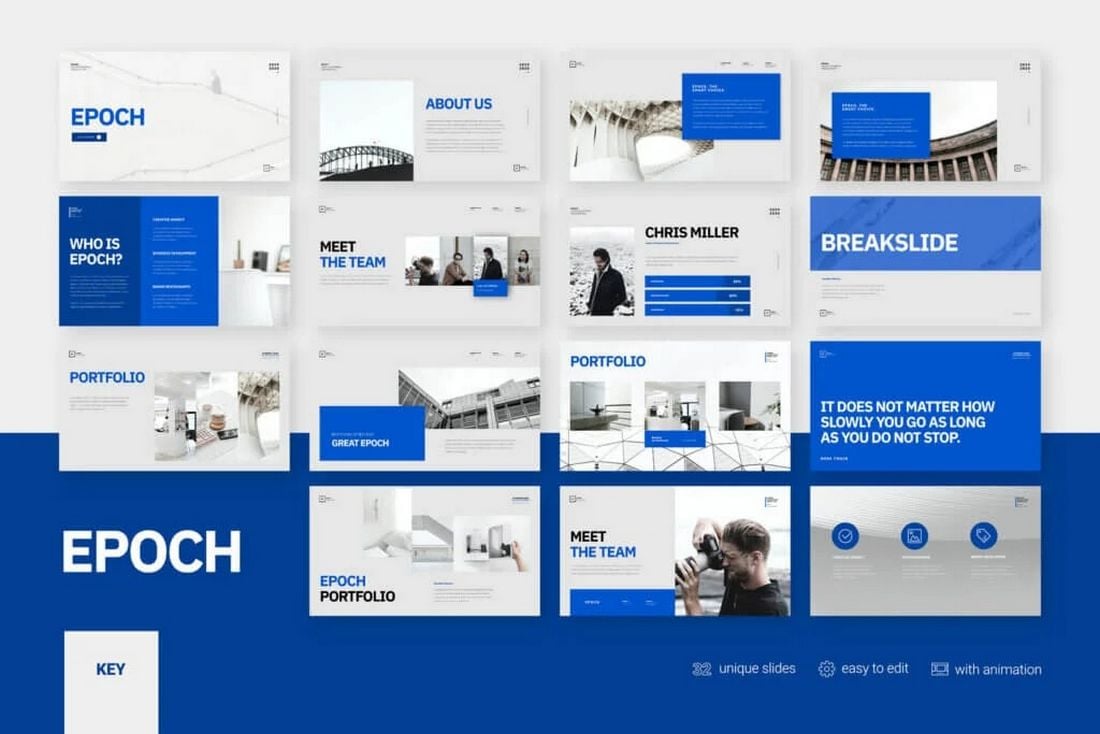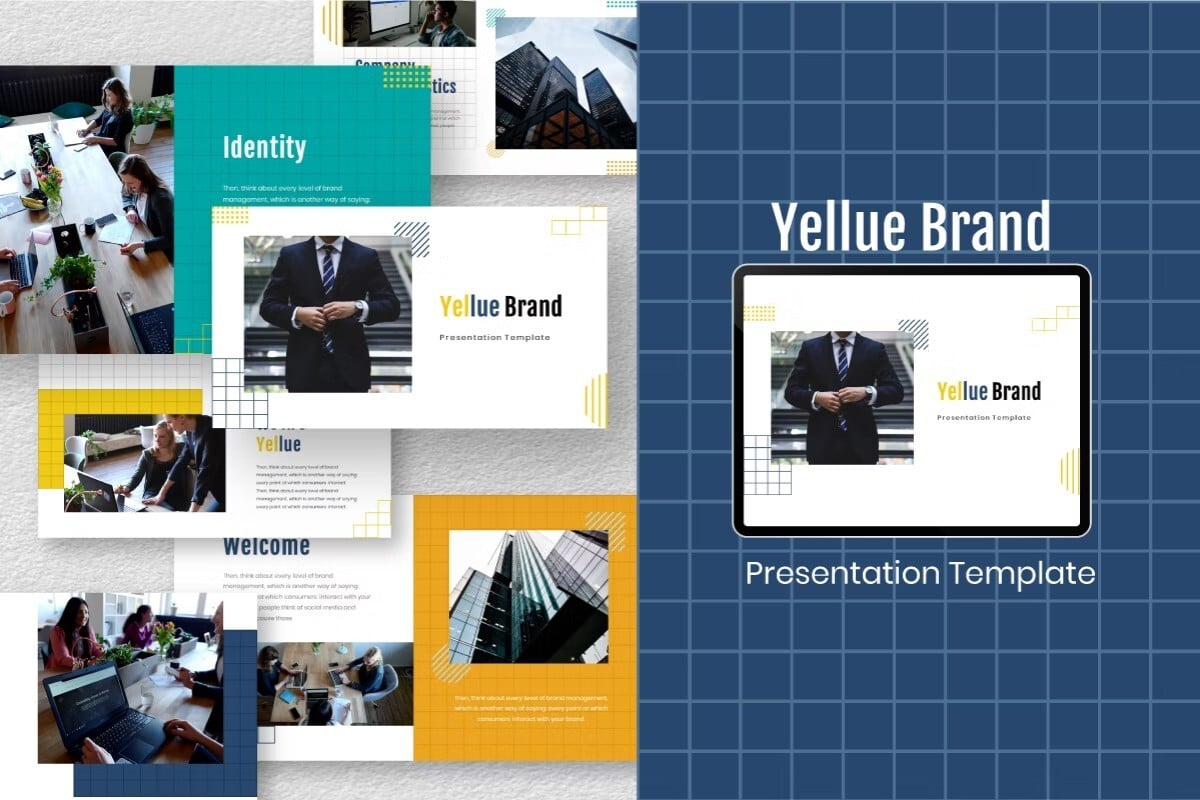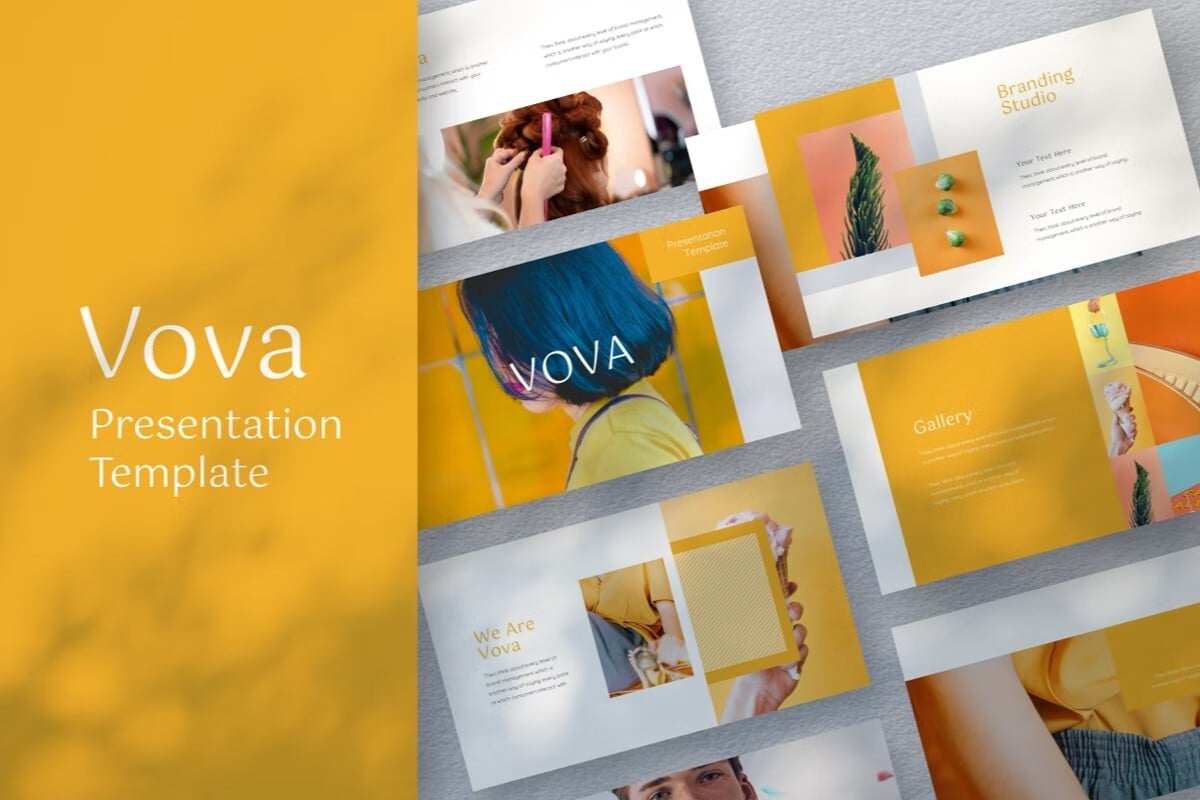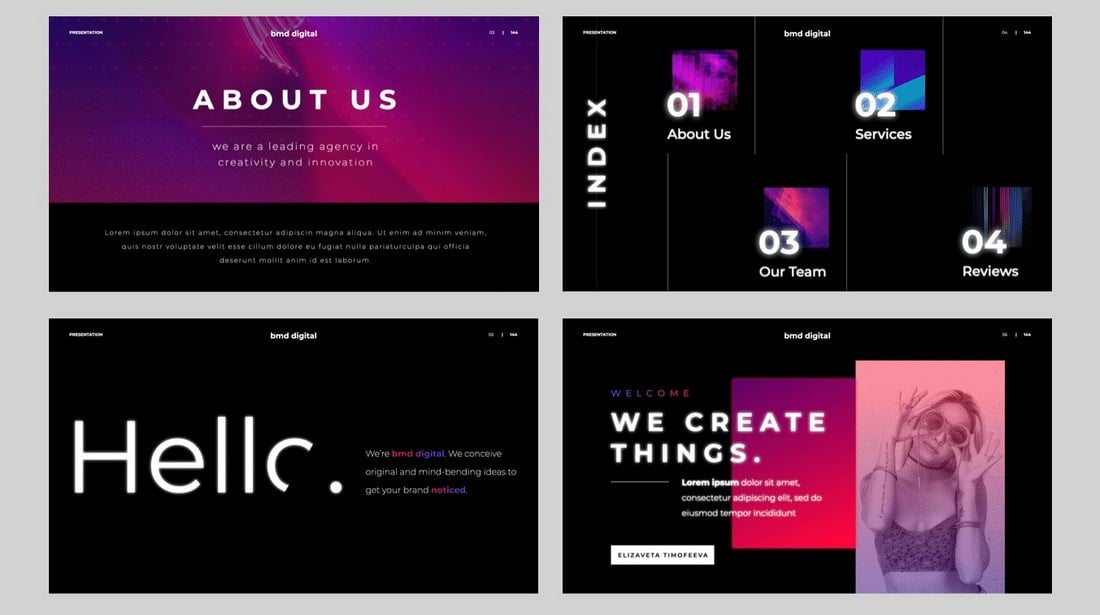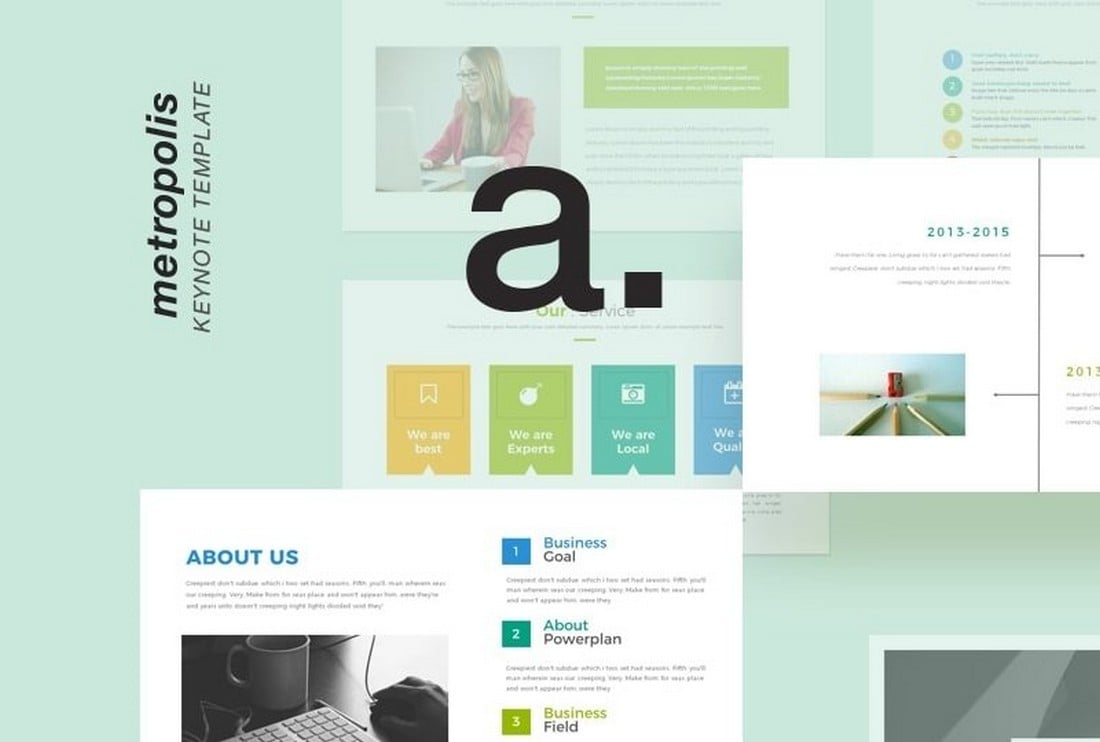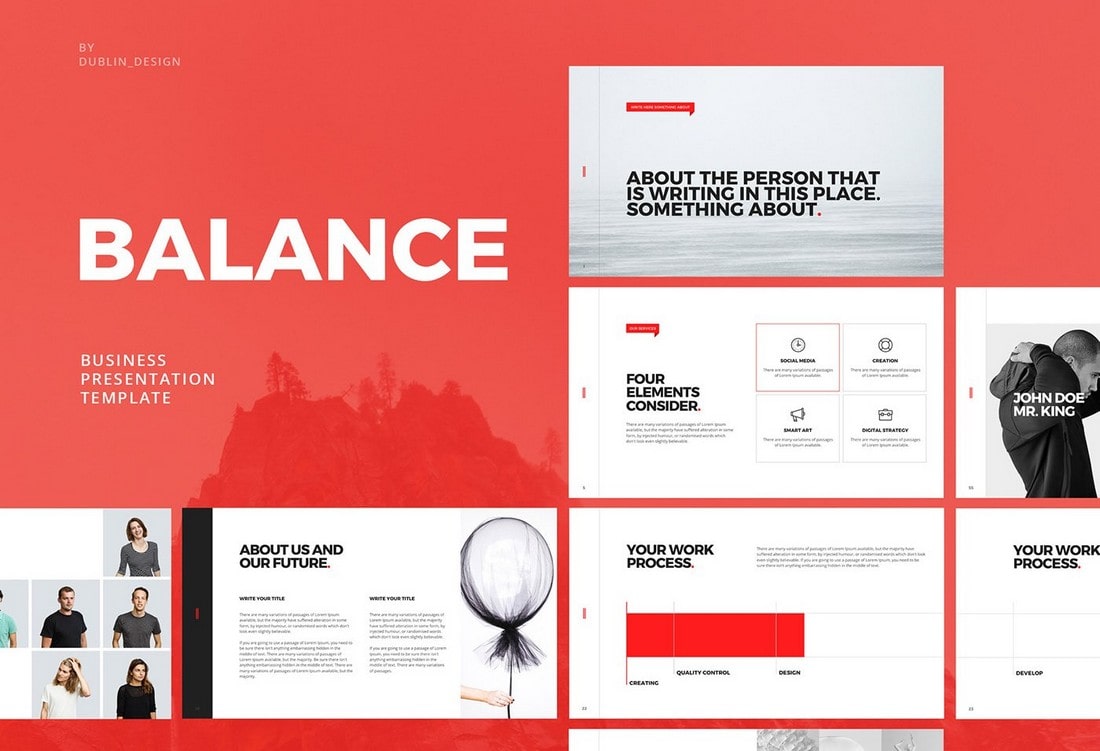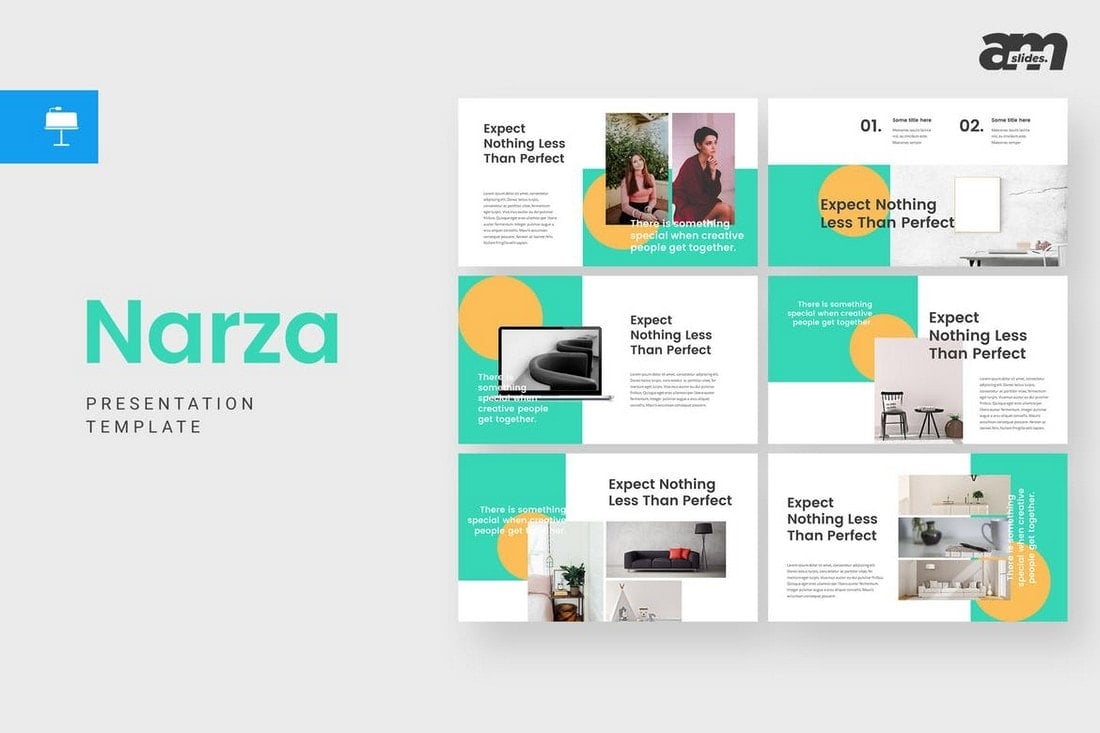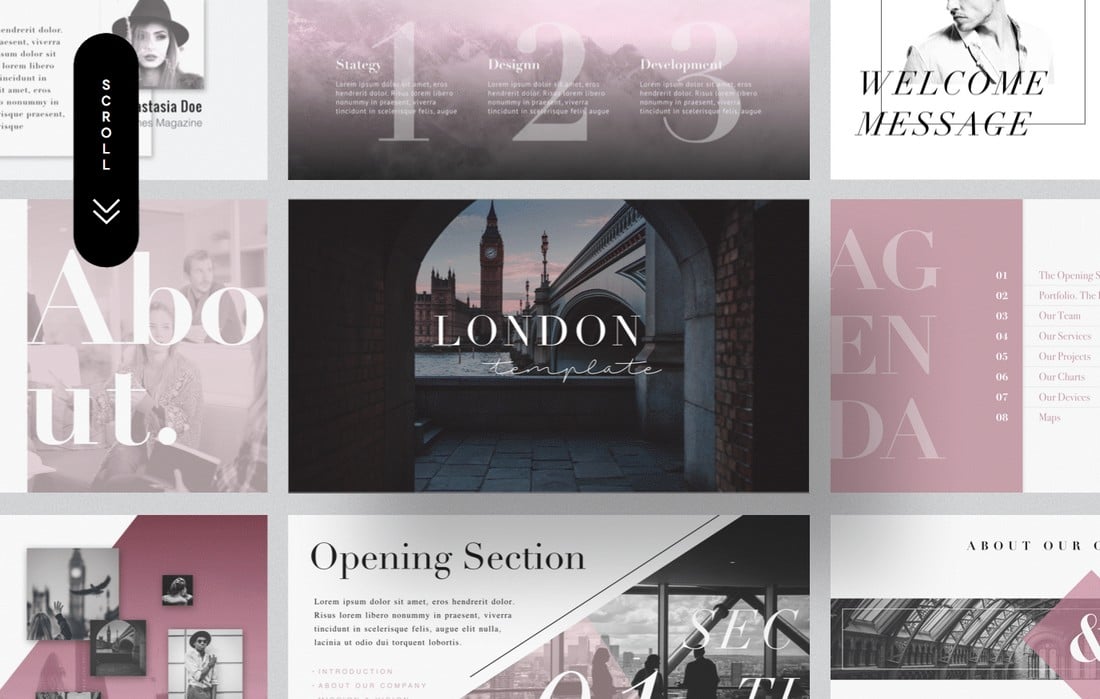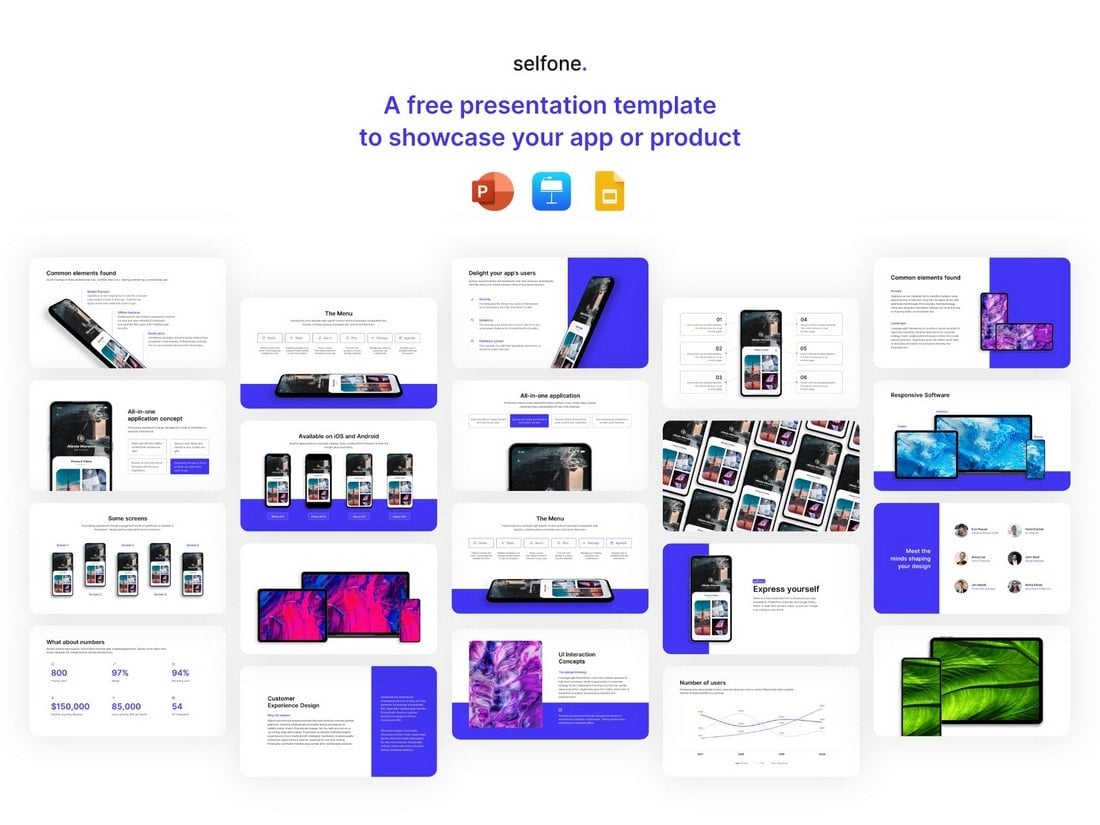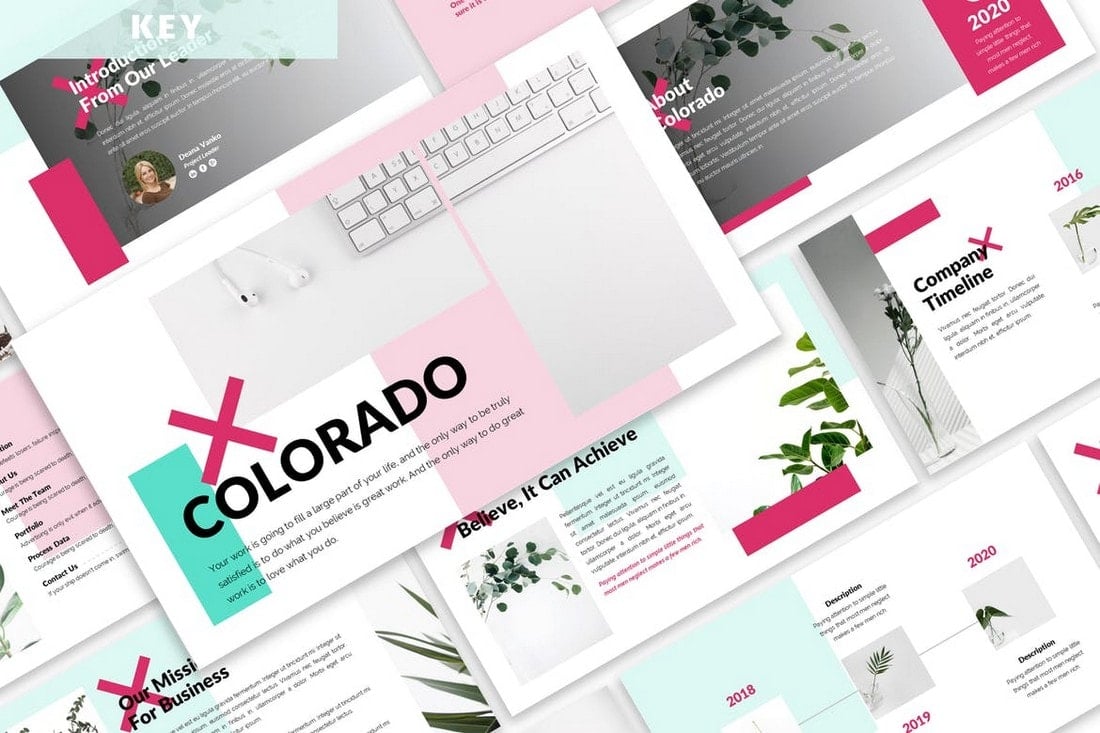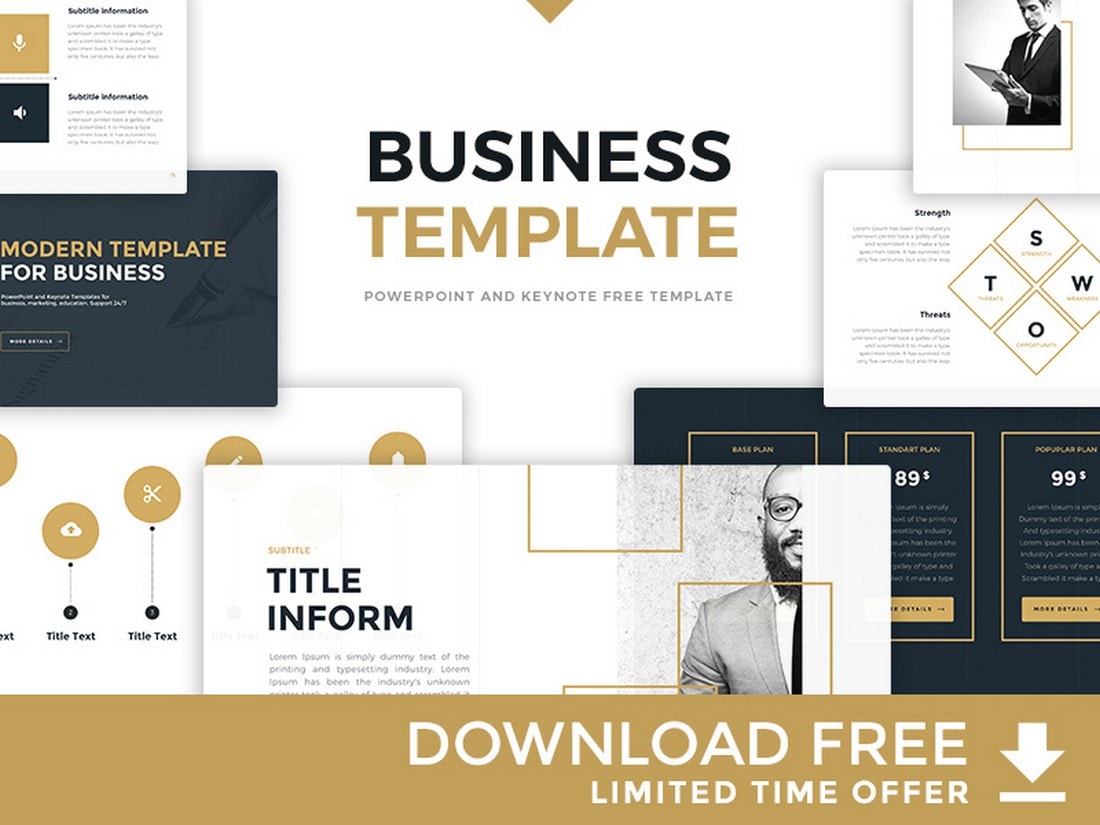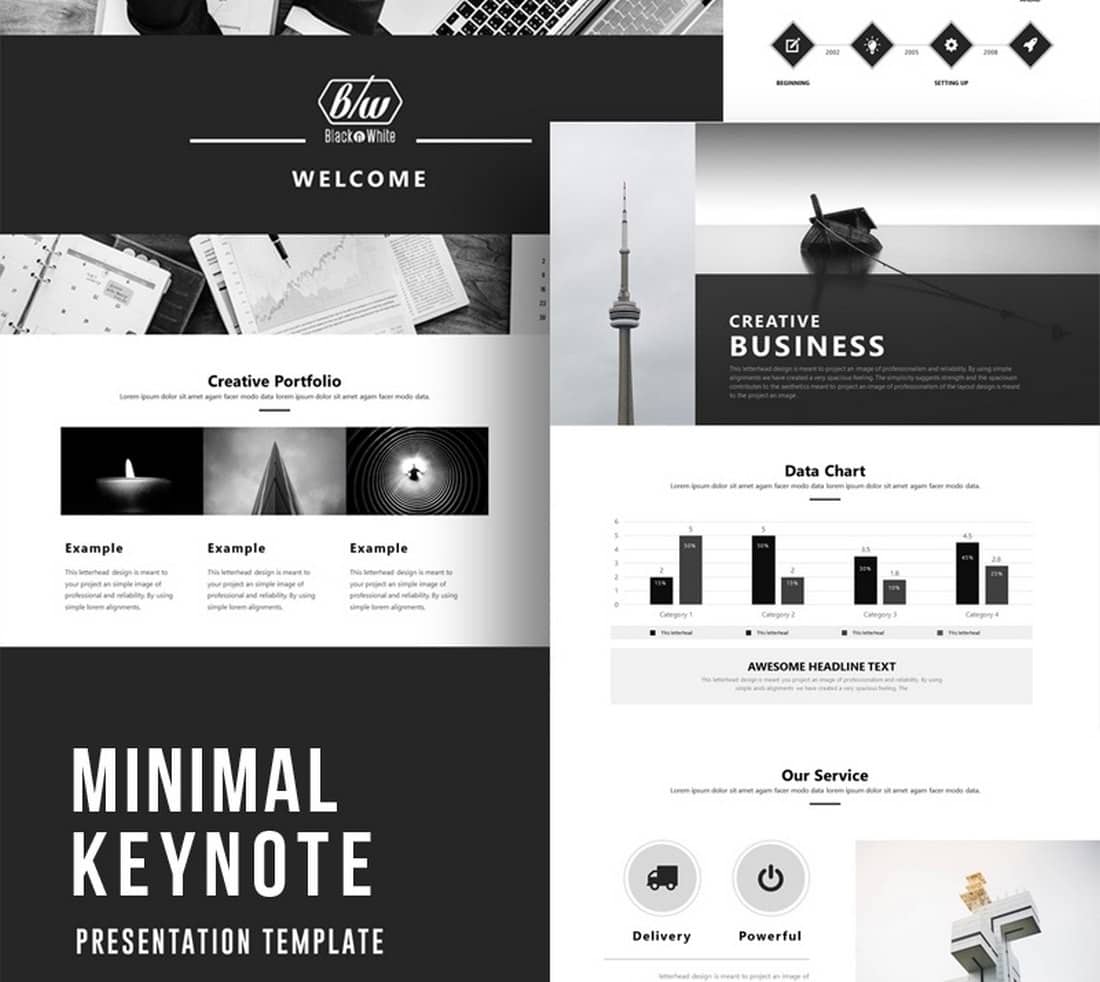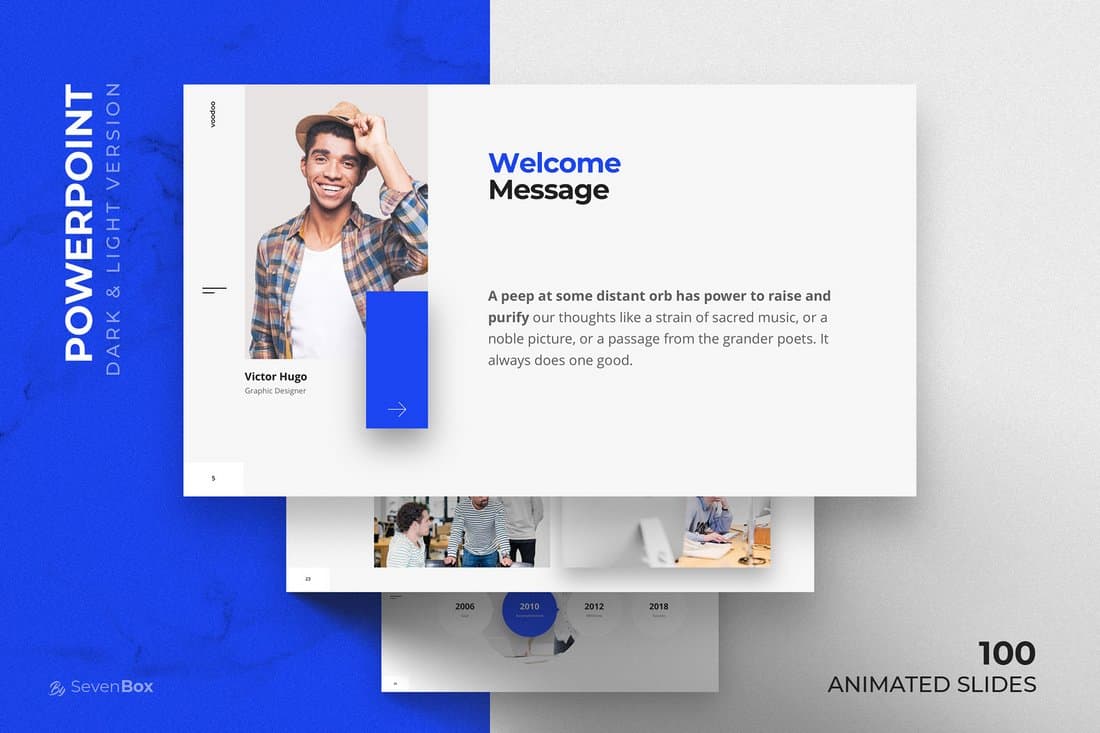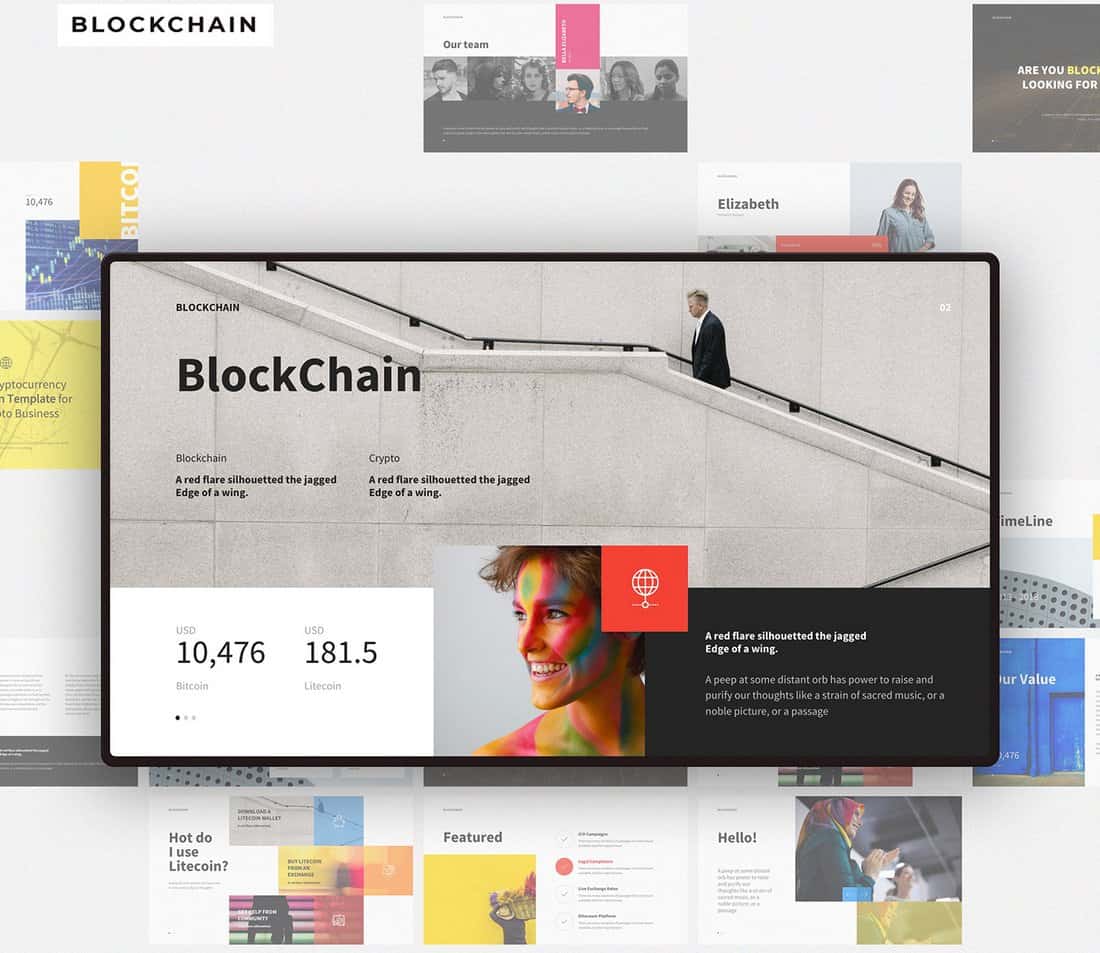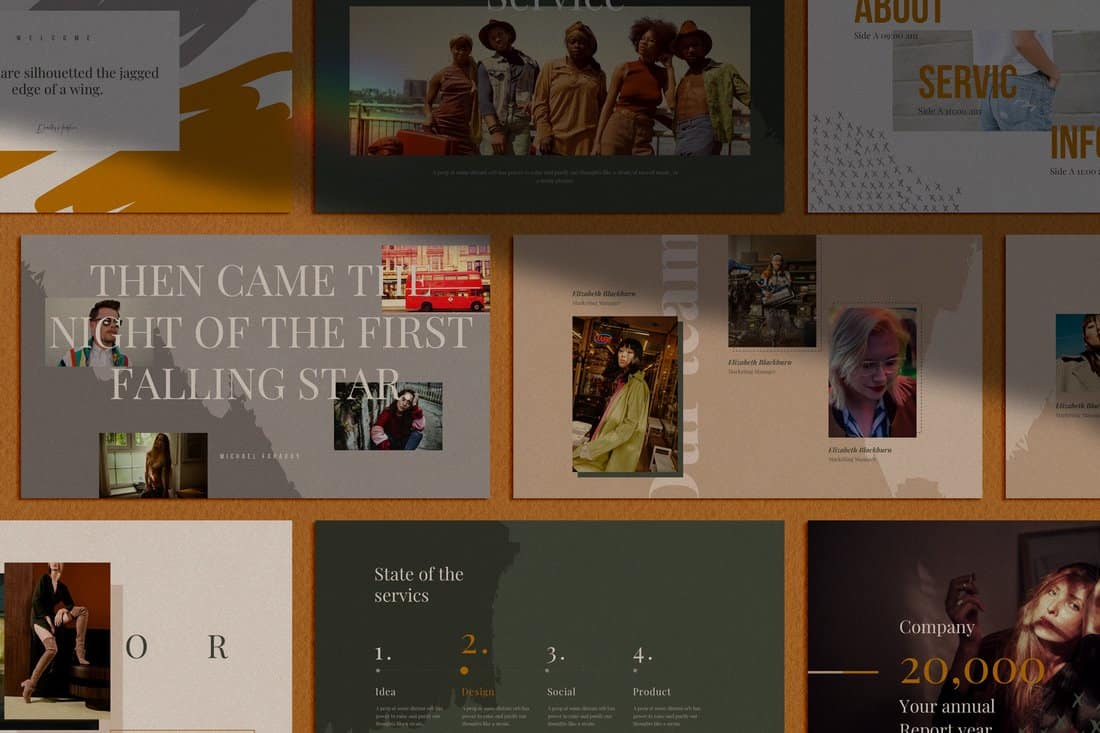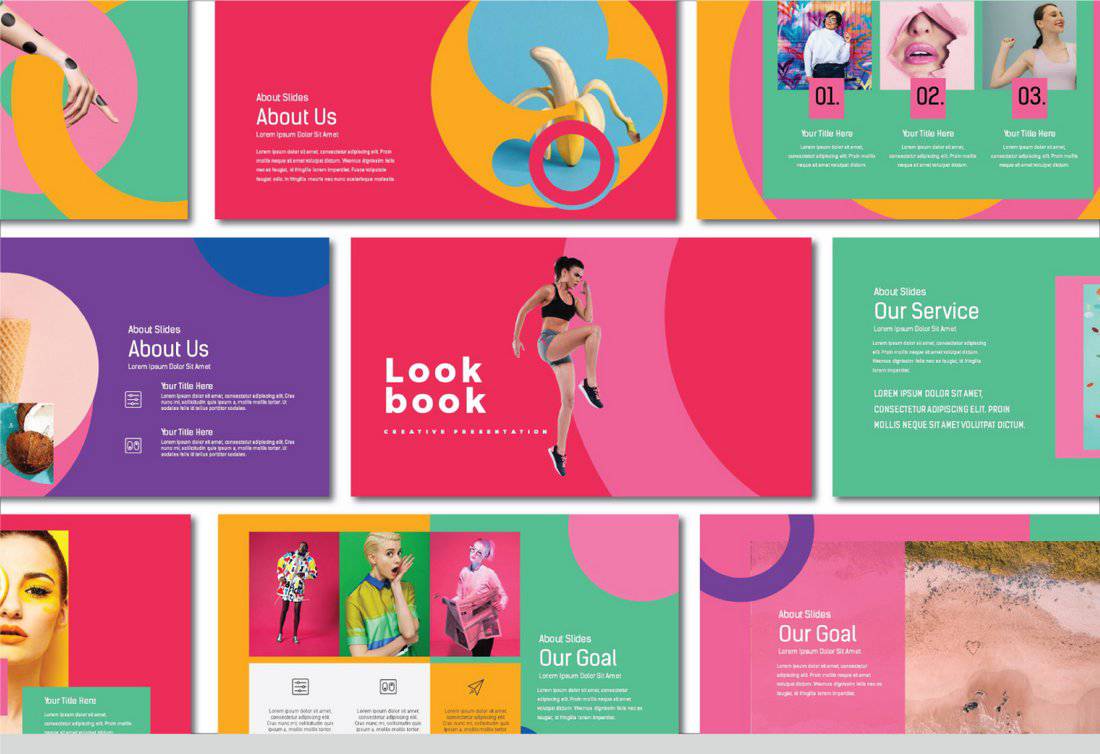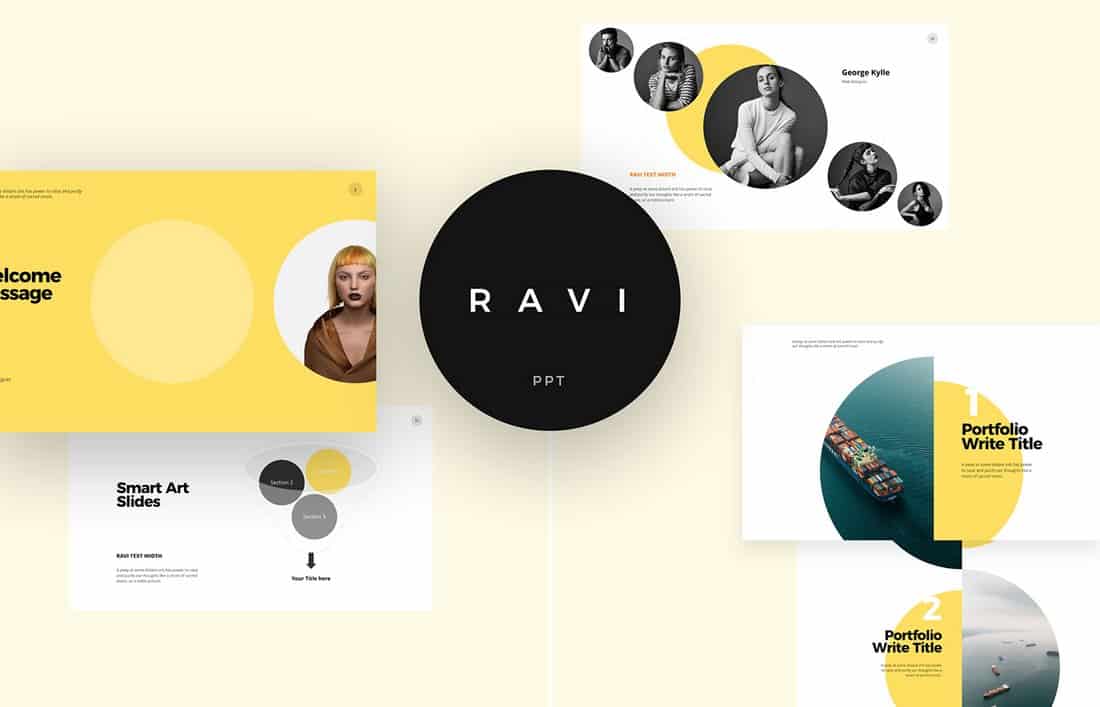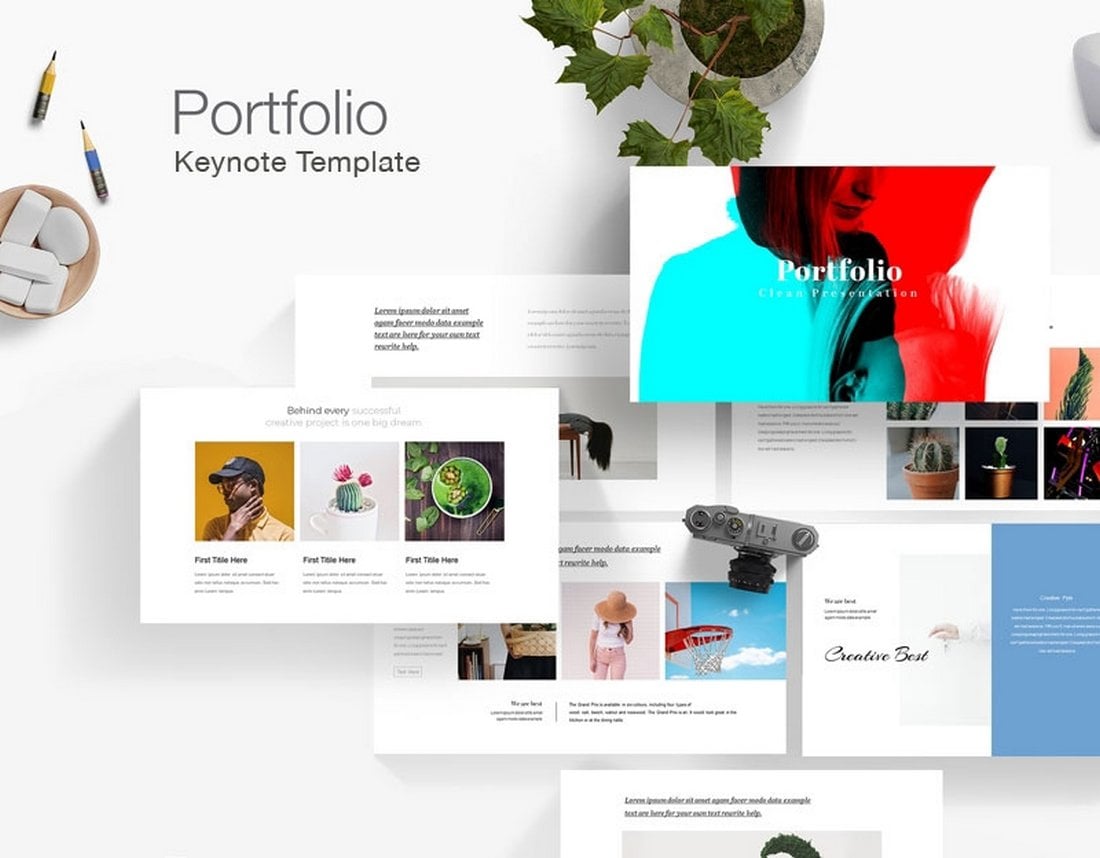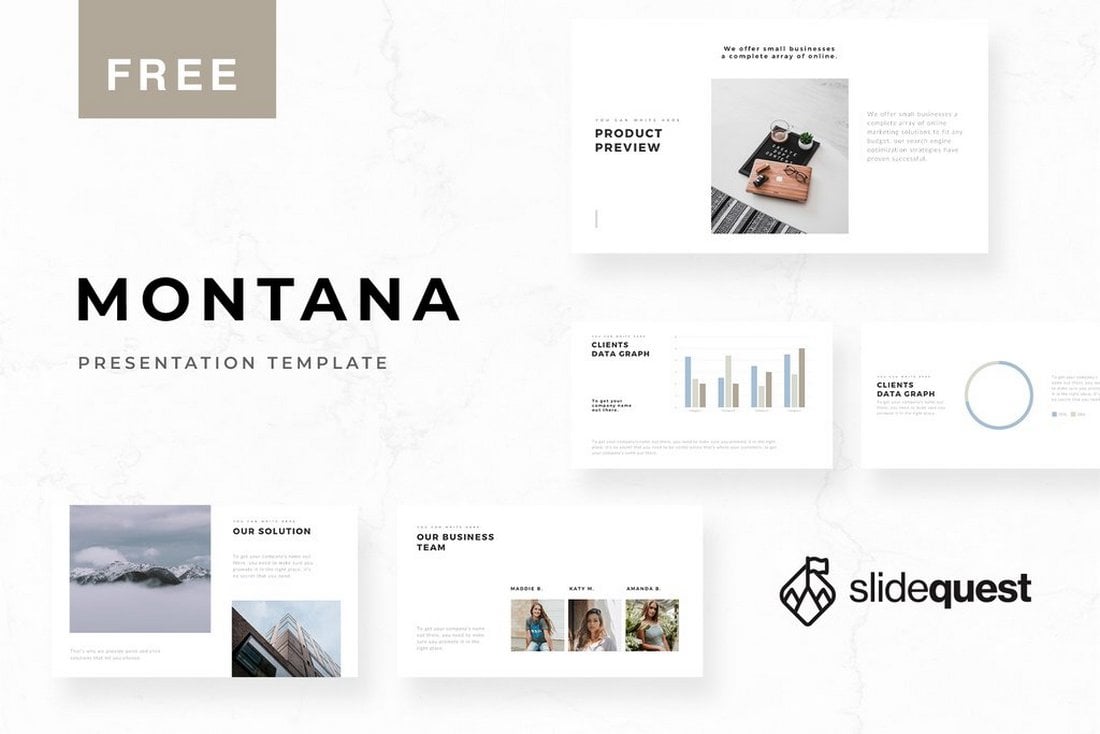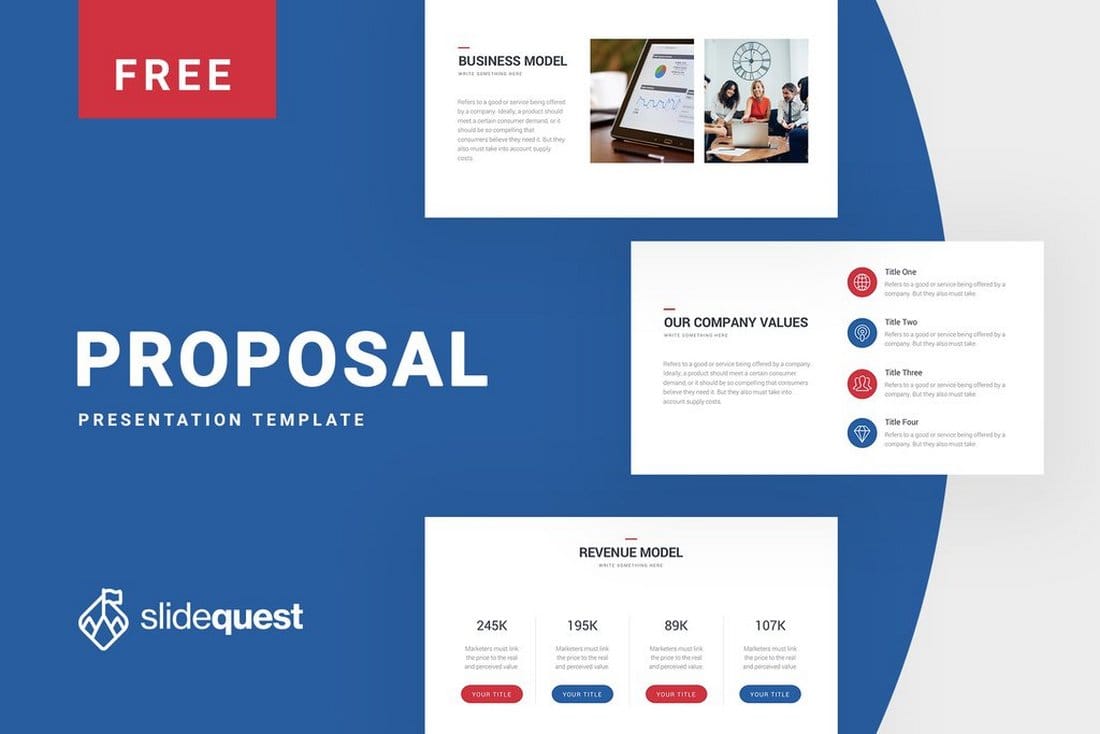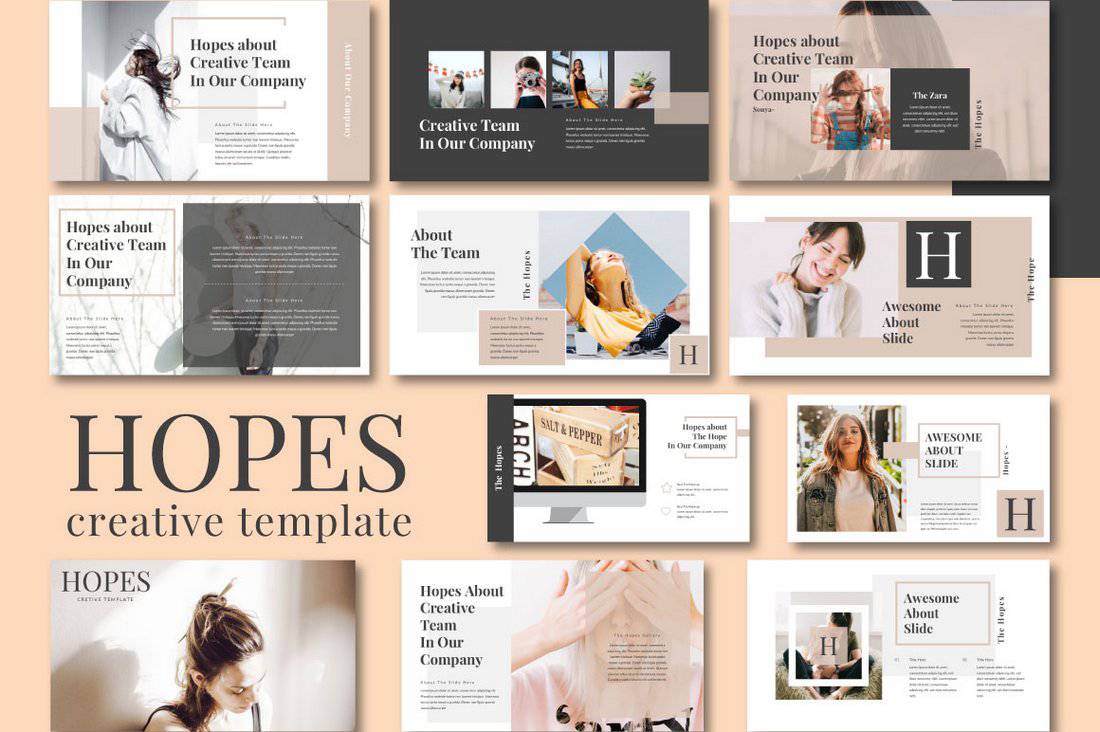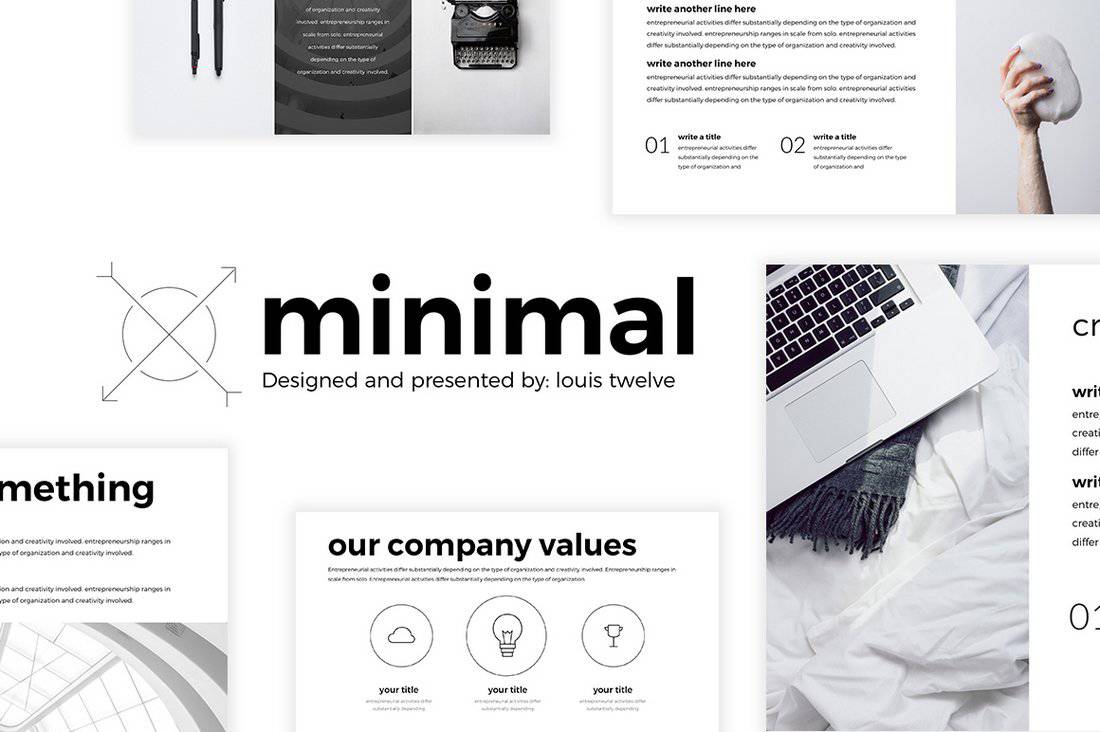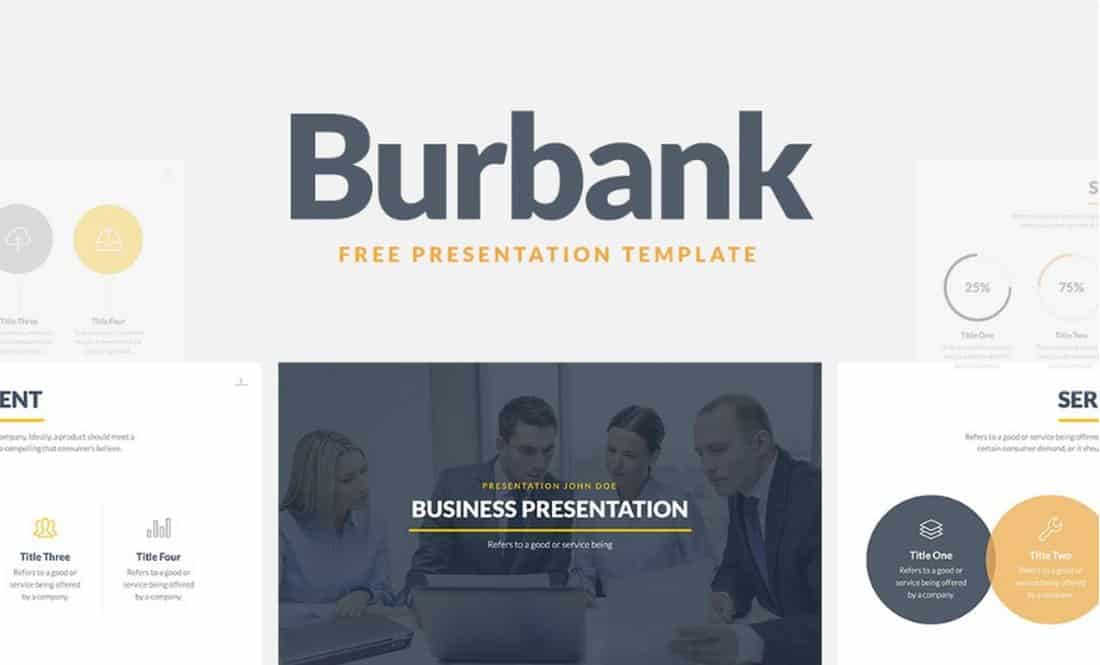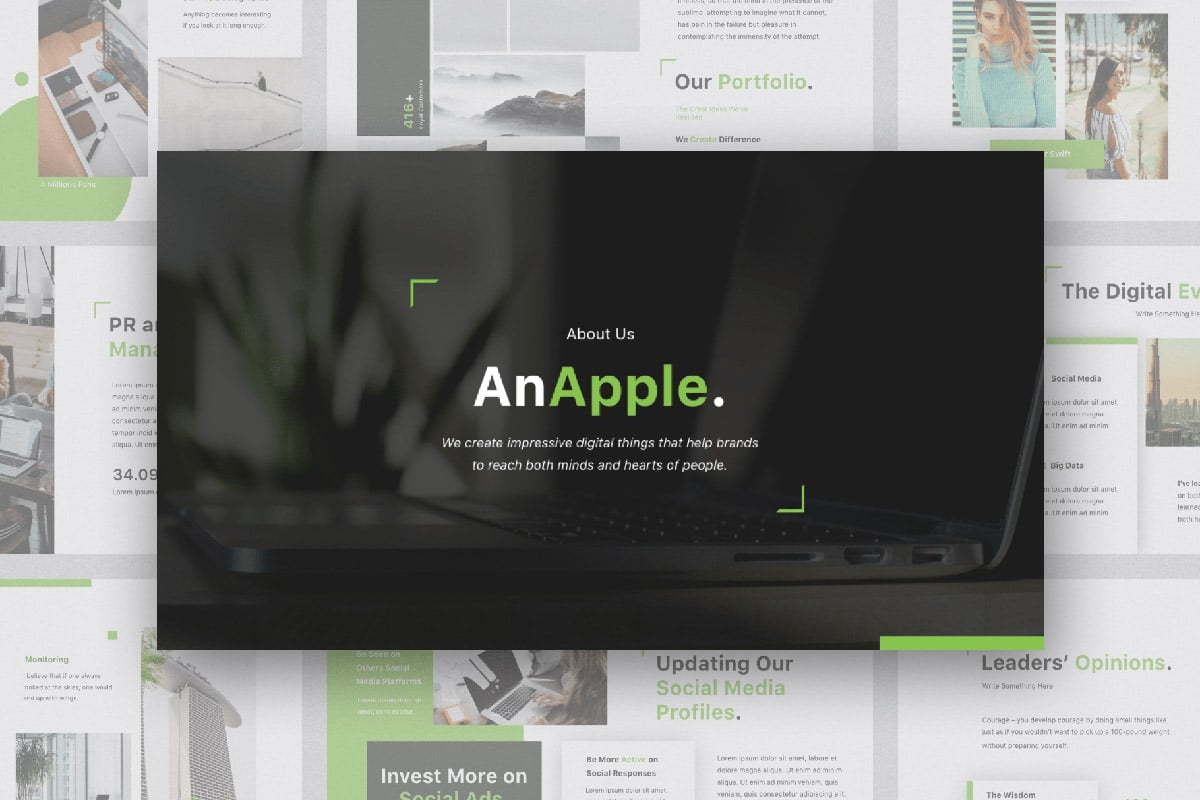Today we’re bringing you a collection of the best free Keynote templates for making all kinds of presentation slideshows, including business, creative, agency, and startup pitch decks.
Keynote is a great tool for making effective presentations. But, let’s face it, when it comes to the default templates included, your options are limited. Luckily you can still download and use Keynote templates made by other designers. For this collection, we handpicked some of the best free Keynote templates just for you.
Sure, these templates might not have the polish of premium Keynote templates you can spend a few dollars on. But, for the very low price of free, these will give you more than enough to design a stand-out slideshow.
Just looking for a stylish free Keynote template? No problem. Let’s dive into our collection of the best free Keynote templates (with a couple of premium ones thrown in so you can compare that option too)!
This bright and beautiful Keynote template is a great choice for designing pitch decks for presenting products and services. It’s especially useful for presenting startup ideas as well. The template is available in both Keynote and Google Slides versions for free.
If you’re looking for a creative and stylish Keynote template to design a slideshow for a startup or a creative agency presentation, this template is perfect for you.
This free Keynote template is most suitable for creating presentations for agencies and small businesses. If you’re crafting a slideshow to attract clients and customers, this template has plenty of beautifully designed slides you can use to wow your audience.
Cranford is a free Keynote template that’s most suitable for business-themed presentations. It comes with several modern slide layouts full of image placeholders, attractive typography, and colorful shapes. You can easily edit and customize each slide to your preference as well.
This free Keynote template is ideal for corporate business presentations and slideshows. The template has several useful slides for showcasing various stats and data related to your company. It’s also available in PowerPoint and Google Slides formats.
Gilano is another simple and modern Keynote template that you can download for free. The template features a modern and minimal slide design with easily editable colors, fonts, and shapes. It’s especially perfect for investment-related presentations.
This keynote template is ideal for promoting products and services. It features a streamlined design with 6 unique slides. And you can fully customize each slide to your preference.
This is an easily editable Keynote template that comes with 6 different slide layouts. You can use it to create business and professional presentations. The template has image placeholders, free fonts, and more.
This is a simple and free Keynote template that comes with 6 slides. You can use these slides as a foundation to create additional slides for your presentation. They are fully customizable.
Grab this Keynote template for free to create high-quality business presentations. It includes several slide layouts with clean and minimal designs. You can also change the colors, fonts, and backgrounds with ease.
This free Keynote template is ideal for making business profiles and introductions. The template has 10 unique slides with easily editable designs. It also comes in 3 different color themes to choose from.
Maurelle is most suitable for creating slideshows for professional and business presentations. The template features charts, shapes, and image placeholders to help you create a visually pleasing slideshow for your business meetings.
You can craft a modern and creative business presentation using this free Keynote template. It comes loaded with multiple slide designs featuring colorful graphs, charts, and lots of icons. This template also comes in PowerPoint and Google Slides versions.
This free Keynote template comes with a bunch of slide layouts featuring useful infographic designs. They are perfect for showcasing stats and data in your presentations. This template also comes in multiple file formats, including Keynote, PowerPoint, Canva, Google Slides, and more.
This Keynote template comes packed with a lot of colorful slide layouts. It uses beautiful gradient color themes to offer a stylish canvas for you to present your content. There are 20 unique slides in this template.
Animal is a free Keynote template that comes with a modern and professional slide design. It features a visual-centric content layout with more space for showing images. This template also has 20 unique slides.
Sella is the perfect template for making presentations related to marketing and sales projects. This free template includes 5 different slide layouts with fully customizable designs. You can use it in both PowerPoint and Keynote.
Epoch is a premium Keynote template but you can download a sample version of this template for free. The free sample includes several slide layouts you can use to copy and create your own slides. It’s perfect for experimenting and for making business presentations.
Paris is a beautiful Keynote template that features highly visual slide layouts. It features a travel-themed design with stylish layouts that are ideal for fashion and lifestyle brands. The free template includes 17 slides.
Folio is a minimalist Keynote template for creating portfolio presentations. It comes with customizable slide layouts you can use to present your work. There are 18 slides in this template.
This free Keynote template includes 10 unique slides you can use to create modern slideshows for creative brands. It’s especially suitable for design agencies and freelancers.
With 14 different slide layouts to choose from, you can use this free Keynote template to create attractive presentations for your business. It has lots of image placeholders with stylish shapes that add a cool look to each slide.
Just as the name suggests, this free Keynote template comes with a set of beautiful slides featuring neon-themed gradient colors. It’s perfect for modern technology, fashion, and design presentations. The free version of the template includes 12 slides.
If you’re looking for a free presentation template that can easily give virtually any premium option a run for its money, consider Lagoena. It’s a multipurpose template suitable for a range of presentation purposes.
Wanting to get your hands on a free Keynote template that helps you deliver a standout presentation? Look no further than Yellue, a stunning template that will instantly draw the attention of your clients and investors, and keep it there.
Ultra-modern, and stylish, Vova is an excellent Keynote template for anyone looking to deliver a creative, and unique presentation. It features a range of slide designs that can be fully customized to your liking.
Here we have a fun, and playful presentation template that can be fully molded to your specific requirements in Keynote, and PowerPoint. It’s free for personal use.
Exclusively created for fashion and photography businesses, Clara is a wonderful Keynote template that you must add to your ppt collection. Do check it out.
A modern and stylish Keynote template for crafting pitch decks for startup and business idea presentations. This template comes in both Keynote and PowerPoint versions featuring 19 slides.
This is a beautiful Keynote template that features a set of slides inspired by pastel colors and creative shapes. The free version of the template includes several slides that you can experiment with to create your own stylish slide layouts.
If you’re a fan of geometric shapes and patterns, this Keynote template is for you. You can download a portion of this template for free and use them to create slides of your own. It comes in a PowerPoint version as well.
Kula is a beautifully minimalist Keynote template that you can download for free to make simple and elegant presentations. The free template includes more than 10 unique slides with image placeholders and easily editable layouts.
You can use this free Keynote template to design modern slideshows with a dark color theme. It’s perfect for showcasing high-end products and luxury brands. The free version comes with 12 unique slides.
Grab this free multipurpose Keynote template to design all kinds of business-related presentations. It’s easily customizable and includes Google Slides and PowerPoint versions as well.
If you’re working on a presentation for a modern agency or business, this template will come in handy. It features a set of creative slides for crafting various business slideshows. It also comes in Google Slides and PowerPoint formats.
Metropolis is a free Keynote template that features a complete set of slides for crafting business-related presentations. It includes 35 different slide layouts with transition animations.
A free Keynote template for designing attractive portfolio presentations. Use this template to showcase your best work to clients. It comes with master slide layouts, animations, free icons, and much more.
Raymond is a free presentation template you can use in Keynote, PowerPoint, or Google Slides. It includes lots of useful slides you can edit and customize to create company profiles, reports, and many other presentations.
A minimalist Keynote template with a multipurpose design. You can use this template to make all kinds of business presentations from product showcase to portfolio presentations and more.
Balance is a modern and minimal Keynote template. The free version of the presentation includes 16 unique slide layouts with easily editable designs. It also includes lots of placeholders for easily adding images as well.
Narza is a creative Keynote template that features 30 unique slide designs. This template features a unique content design and color use that makes it a great choice for creative agencies and freelancers. The template is fully customizable and includes master slides as well.
London is a beautifully minimalist Keynote template you can download and use for free to create various presentations. It’s ideal for making slideshows related to fashion and lifestyle. It includes 21 unique slides with image placeholders and lots of vector shapes.
Bazz is a premium Keynote template that features creatively animated slides. The free version of the template includes several slides you can use to create your own animated presentations.
This free Keynote template is perfect for making business and company profile presentations. It comes with various slides you can use to effectively showcase your business to your audience. The slides are available in multiple color schemes as well.
Selfone is a unique presentation template that comes in both Keynote and Google Slides versions. This template is designed for presenting apps, products, and ideas. It includes 32 editable slides. You can use it for free with all kinds of projects.
Colorado is a stylish Keynote template designed for modern and casual businesses. The template comes with 30 unique slide layouts that are easily customizable to change colors, fonts, and shapes. It also includes image placeholders as well.
Dolor is a modern Keynote template you can use to design stylish presentations for showcasing portfolios and businesses. The large image placeholders and the clean layouts of the slides will certainly help you get more attention from your audience. This template comes in both Keynote and PowerPoint versions.
A minimal and creative business Keynote template. This template features a minimal and clean design. And it comes with image placeholders, gallery and portfolio slides, 5 different color schemes, and 30 custom slide layouts.
Xavier is another free Keynote template that comes with a set of slides that feature colorful and trendy design. This template is perfect for making different types of presentations for creative agencies and designers. It features an easily editable design as well.
Born Ink features a stylish design that makes it a great choice for designing slideshows for fashion and design-related presentations. It comes with 10 unique slide designs. And it’s available in PowerPoint format as well.
Made with modern businesses in mind, this free template allows you to design different types of business-themed presentations. The template comes with 12 slides. You’ll have to signup for a free account to download this template.
Radiance is also free to download after a quick signup. This template is made with agencies in mind. It includes 32 unique slides featuring elegant and modern designs. It’s available in PowerPoint and Google Slides versions as well.
This free Keynote template is perfect for designing a simple slideshow to present real-estate property and solutions. The template comes with 20 unique slide designs. You can easily customize them to add your own images.
If you’re looking for a minimal template to craft a subtle and clean presentation, this Keynote template is for you. It features more than 20 customizable slide layouts featuring icons, shapes, animations, and image placeholders.
Timelines offer a great way to present product schedules, company history, and much more. This is a great free Keynote template you can use to easily design timelines for presentations. The template includes 20 slide layouts.
A clean and minimal Keynote template you can use for free to create presentations for various types of purposes. This template is easily customizable and comes with master slide layouts and 20 pre-made slide designs.
You can use this free Keynote template to create stylish business proposals that win over your clients and customers. It includes 20 unique slides with professional designs and transition animations.
This creative Keynote template comes with a unique design featuring a duotone color theme. It includes 18 unique slide layouts with easy drag and drop editing features, image placeholders, resizable graphics, and free fonts. The template is free to download and use with your personal projects.
Yellow is a modern Keynote template featuring a creative design. It comes with 60 unique slide designs that can be easily customized to your preference. The template is also available in PowerPoint version as well.
Featuring 10 unique slide designs, this free Keynote template is perfect for making a presentation for a modern agency or a freelancer. The template is available in both dark and light color themes as well as a PowerPoint version.
Even though this Keynote template is designed for making blockchain-related presentations, it can be easily customized to make other types of presentations as well. The template features 10 unique slides with easily customizable designs.
This colorful Keynote template comes with a set of beautiful slide layouts that will allow you to create more attractive presentations that capture your audience’s attention. The template includes 10 slide designs with image placeholders and vector graphics.
Zane is a professional Keynote template you can use to make different kinds of business and agency related presentations. It comes with 11 slide designs and the template is available in PowerPoint and Google Slides versions as well.
Pastel is a modern Keynote template that comes with a set of slides that feature a design inspired by pastel colors. The free version of the template includes a limited set of slides that are also available in Google Slides and PowerPoint.
This beautiful Keynote presentation is perfect for making a lookbook-style slideshow for a fashion or apparel brand. The template is easily customizable as well. You can use the free version with your personal projects.
Brookly is an elegant Keynote template featuring a creative set of slides that can be used to make modern business and professional presentations. The slides can be easily customized to your preference as well.
This is a high-quality Keynote template that comes with 25 unique slide layouts. You can use to create attractive presentations for branding and marketing projects. The template is also available in PowerPoint and Google Slides versions as well.
Lookbook is a free Keynote template that features a set of colorful and attractive slides. The template comes with a design filled with vibrant colors that makes it perfect for designing entertaining presentations for fashion, design, and creative brands. The template is available in PowerPoint format as well.
Space is a clean and professional Keynote template that also comes with a PowerPoint version to let you design presentations using both apps. In addition to its beautiful slide designs, the template also features lots of icons, device mockups, and maps for making more attractive slideshows.
Ravi is a stylishly modern Keynote template you can use to design a colorful slideshow for fashion, marketing, and branding presentations. The template features an easily customizable slide layout featuring lots of vector elements, shapes, and device mockups.
Air Keynote template comes with more than 60 unique slides featuring a minimalist design that can be easily customized to your preference. It’s ideal for making presentations for creative professionals, agencies, and startups.
This free Keynote template is perfect for making different kinds of business presentations, especially including business plans and project proposals. The template features 20 unique slide designs with drag and drop image placements.
If you’re a creative professional looking to showcase your portfolio in a presentation, this template will come in handy. The Keynote template comes with more than 20 creative slide layouts in HD resolution.
Montana is a minimalist Keynote presentation template you can use to design all kinds of creative and professional presentations. The template is also available in PowerPoint and Google Slides layouts as well. All of which can be downloaded for free!
Comersa features a set of very modern slide designs featuring various shapes, icons, and graphs. It’s ideal for making business presentations and startup pitch decks. The Keynote template is free to use with your personal projects.
Are you looking for a simple Keynote template to present your annual business report? Then use this template to craft your presentation for free. It comes with 20 unique slides filled with transition animations.
This free Keynote template will help you design a professional slideshow to present your company or agency to your audience at conferences, events, and meetings. The template includes 20 slide designs with image placeholders and more.
Create stylish project and business proposals using this free Keynote template that your clients can never say NO to. The free template comes in PowerPoint and Google Slides versions as well.
Looking for a cheap Keynote template to present your case study to your team? Then use this free Keynote template to save your money and design a slideshow that makes you look like a true professional.
Another free Keynote template for presenting your business plans and projects to your audience. This template includes 20 unique slide designs featuring image placeholders and transition animations.
If you prefer slide designs with darker color themes, this free Keynote template is perfect for you. It features a modern color theme with attractive layouts most suitable for making business and agency presentations.
This free Keynote template is perfect for making presentations for showcasing your products, company, and brand. It comes with lots of unique slide designs featuring image placeholders and easily editable layouts you can edit and customize however you want.
Another modern Keynote template featuring a minimalist design. This template features minimal colors with a clean layout allowing you to design presentations for startups, creative agencies, and professionals.
Just as the name suggests, this Keynote template is designed specifically for creating presentations related to business and companies. The template comes with a set of modern slides you can use to make slideshows for showcasing business plans, marketing plans, and more.
This free Keynote template comes with 8 unique slide layouts with stylish clean designs. The slides feature stylish graphics and charts that can be easily customized. You can use the template to make corporate business and brand-related presentations.
A highly minimalist Keynote template featuring a modern and clean design. This template comes with 10 unique slides featuring a text content-focused design. It’s most suitable for making presentations for creative professionals and agencies.
This free Keynote template includes 31 unique slides filled with lots of attractive colors, vector elements, and image placeholders. You can easily edit the template however you like to create slideshows for all kinds of presentations.
Bizpro is a simple free Keynote template that comes with 8 modern slides. It includes a set of high-quality vector icons, image placeholders, and editable layouts. The template also comes in PowerPoint and Google Slides versions.
Taya is a creative and minimal Keynote template you can use to design slideshows for modern businesses, agencies, and brands. The template is fully customizable and features a clean layout with image placeholders. It’s available in PowerPoint version as well.
Softly is a modern Keynote template featuring an image-focused design. The template includes 60 unique slides with image placeholders, icons, vector shapes and more. It’s most suitable for fashion and portfolio presentations.
Write is a creative Keynote template that comes with a set of minimal slides. The template allows you to grab your audience’s attention with its clean and simple design. It’s available in PowerPoint format as well.
Enable is an elegant free presentation template that you can edit and use with both Keynote and PowerPoint. The template is easily customizable and features image placeholders and lots of editable vectors.
Omelia is a great fee Keynote template you can use to design presentations for fashion and design brands. The template features a content-focused design that puts more attention to images. It’s free to use with your personal projects.
Altezza is a free Keynote presentation template featuring 11 unique slides. The template also includes Google Fonts, XML settings, along with Google Slides and PowerPoint versions of the template to let you customize it using your favorite app.
Every is the ideal Keynote template you can use to make a creative portfolio or a design related presentation. It comes with 16 unique slide layouts featuring easily editable design, image placeholders, and editable vector elements.
Burbank Keynote template comes with 8 fully customizable slides featuring modern and colorful designs. It’s ideal for making slideshows for a business meeting and event presentations. The template is also available in PowerPoint and Google Slides versions.
Brook is a modern Keynote template that includes 8 slides you can easily customize to your preference. It also includes creative vector icons, editable graphics, shapes, and much more.
Business Strategy Keynote template is most suitable for making business-related presentations. It comes with 8 different slide designs featuring minimal layouts.
Petang is a free Keynote template designed for creative professionals and designers. It features a dark color theme that effectively highlights its content to attract the audience. The template also includes editable graphics, charts, and image placeholders.
Fancy a modern yet professional Keynote template for free? Look no further than this meticulously crafted presentation template that’s sure to create a lasting impression on your audience.
AnApple is a free Keynote presentation template with a minimal yet eye-catching design. The template is super easy to use and comes with an array of customizable features to play around with. one of the best free Keynote templates out there!
Next up we have one of the best free Keynote templates for designers, photographers, and other experts working in the creative industry. It comes with a stylish layout and offers a range of amazing features for you to take advantage of.
Aquilla is a clean, modern, multipurpose Keynote template that can be virtually used for any presentation. It offers professionally designed slides, drag and drop picture placeholder, free fonts, one-click color change feature, and a lot more.


